Most PC gamers know that ray tracing is a very performance-intensive feature, and depending on the improvement to visual quality, it may or may not be worth using. In an extensive Hardware Unboxed video (watch below), we examined the visual benefits that ray tracing can bring in 37 different games. However, today’s article solely focuses on the performance impact of ray tracing.
Having analyzed visuals first, we can provide far more insights and context to the performance discussion than ever before. We’ll examine the overall performance cost of ray tracing in a ton of games, while also narrowing our focus to titles where ray tracing genuinely enhances visual quality.
How many FPS do you typically need to sacrifice before the benefits of ray tracing become evident and transformative?
Here are two compilation tables of all the games we visually tested and assessed whether ray tracing brought real visual quality benefits in gameplay, where it didn’t, or worse off, where it hurt graphics quality.
Table 1: Games Where Ray Tracing is Not Worth It
| Hurts Visuals | No Improvement At All | If You Look Closely, You’ll See It | Different Image, Unclear if Better |
|---|---|---|---|
| Resident Evil Village | Dead Space | Elden Ring (Low) | Deathloop |
| Gotham Knights | Dirt 5 | Elden Ring (Max) | Forspoken |
| Atomic Heart (Performance) | Resident Evil 4 | A Plague Tale: Requiem | Dragon’s Dogma II |
| The Callisto Protocol (Medium) | Diablo IV (Low) | Far Cry 6 | Diablo IV (Max) |
| Battlefield 2042 | Shadow of the Tomb Raider (Ultra) | ||
| F1 24 (Medium) | Hogwarts Legacy (Low) | ||
| F1 24 (High) | Star Wars Jedi: Survivor | ||
| Shadow of the Tomb Raider (Medium) | Metro Exodus (High) | ||
| Forza Motorsport (Car Reflections) | Metro Exodus (Ultra) | ||
| Forza Motorsport (Max) | |||
| Fortnite | |||
| The Callisto Protocol (High) | |||
| Dying Light 2 Stay Human (Low) | |||
| Spider-Man: Miles Morales (Shadows Only) |
Table 2: Games Where Ray Tracing Effects Are Good or Even Great
| It’s Better, Also More Artifacts | It’s Better, Some Surfaces Only | It’s Generally Better Overall | Transforms Visuals Significantly |
|---|---|---|---|
| Atomic Heart (Quality) | Suicide Squad: Kill the Justice League | Ghostwire: Tokyo (High) | Metro Exodus Enhanced (Normal & Hybrid) |
| Hogwarts Legacy (Ultra) | Doom Eternal | Watch Dogs: Legion (Medium) | Metro Exodus Enhanced (Ultra) |
| Ghostwire: Tokyo (Low) | The Witcher 3: Wild Hunt (Partial Performance) | Watch Dogs: Legion (High) | Alan Wake II |
| Hitman 3 | Guardians of the Galaxy (High) | The Witcher 3: Wild Hunt (Max) | Cyberpunk 2077 (Overdrive) |
| Ratchet & Clank: Rift Apart (Medium) | Guardians of the Galaxy (Ultra) | Control (Medium) | |
| Ratchet & Clank: Rift Apart (Max) | Control (High) | ||
| Black Myth: Wukong (Low) | Dying Light 2 Stay Human (High Quality) | ||
| Spider-Man: Miles Morales (Max) | |||
| Spider-Man | |||
| Spider-Man (High) | |||
| Spider-Man (Very High) | |||
| Black Myth: Wukong (Very High) | |||
| Alan Wake II (Low) | |||
| Cyberpunk 2077 (Ultra) |
This also gives us the ideal opportunity to compare the ray tracing capabilities of Nvidia and AMD’s GPU architectures without the results being skewed by ineffective ray tracing implementations. Ultimately, we only care about ray tracing performance for games where you’d actually consider enabling it, and that’s going to be our philosophy for reviewing the upcoming generation of new GPUs.
No dud games – just the titles that look great today and provide a glimpse into the future of top-tier, ray-traced gaming.
In this ray tracing performance review, we’ll go through 36 games, comparing performance with ray tracing enabled and disabled, using the same configurations seen in the visual analysis.
We benchmarked all of these titles on the current top GPUs – the GeForce RTX 4090 and the Radeon RX 7900 XTX – to provide a clear picture of where things stand. All testing was performed on an AMD Ryzen 7 7800X3D with 32GB of DDR5-6000 memory.
Because these are high-end GPUs, today’s testing focuses on 4K gaming, though we may explore other GPU tiers and resolutions in future content. As discussed in previous articles, there’s no perfect way to benchmark GPUs these days, but we’ve opted for “realistic” gaming configurations that someone enabling ray tracing would likely choose.
In games where both DLSS 2 and FSR 2 or newer are available, we’ve enabled upscaling in Quality mode with a 4K output resolution. In games where one or both of these technologies aren’t available, we’ve stuck to native rendering. No frame generation has been used.
Performance Benchmarks
Resident Evil Village
We’ll work our way through the worst ray tracing implementations to the best, starting with Resident Evil Village. This is a game that actually looks worse with ray tracing enabled; yet, on the RTX 4090, enabling ray tracing at the highest settings leads to a 19% performance drop.
On the RX 7900 XTX, the impact is even greater, with a 33% performance drop, although both cards still deliver over 120 FPS in our test area at native 4K.
Gotham Knights
In Gotham Knights, the issue lies with very low-resolution ray-traced reflections, making the feature essentially pointless in terms of performance impact.
A 35% performance hit on the RTX 4090 and a 24% hit on the RX 7900 XTX are substantial, given the poor quality of the reflections. It’s hard to justify sacrificing this much frame rate when the reflections are so blurry and lackluster.
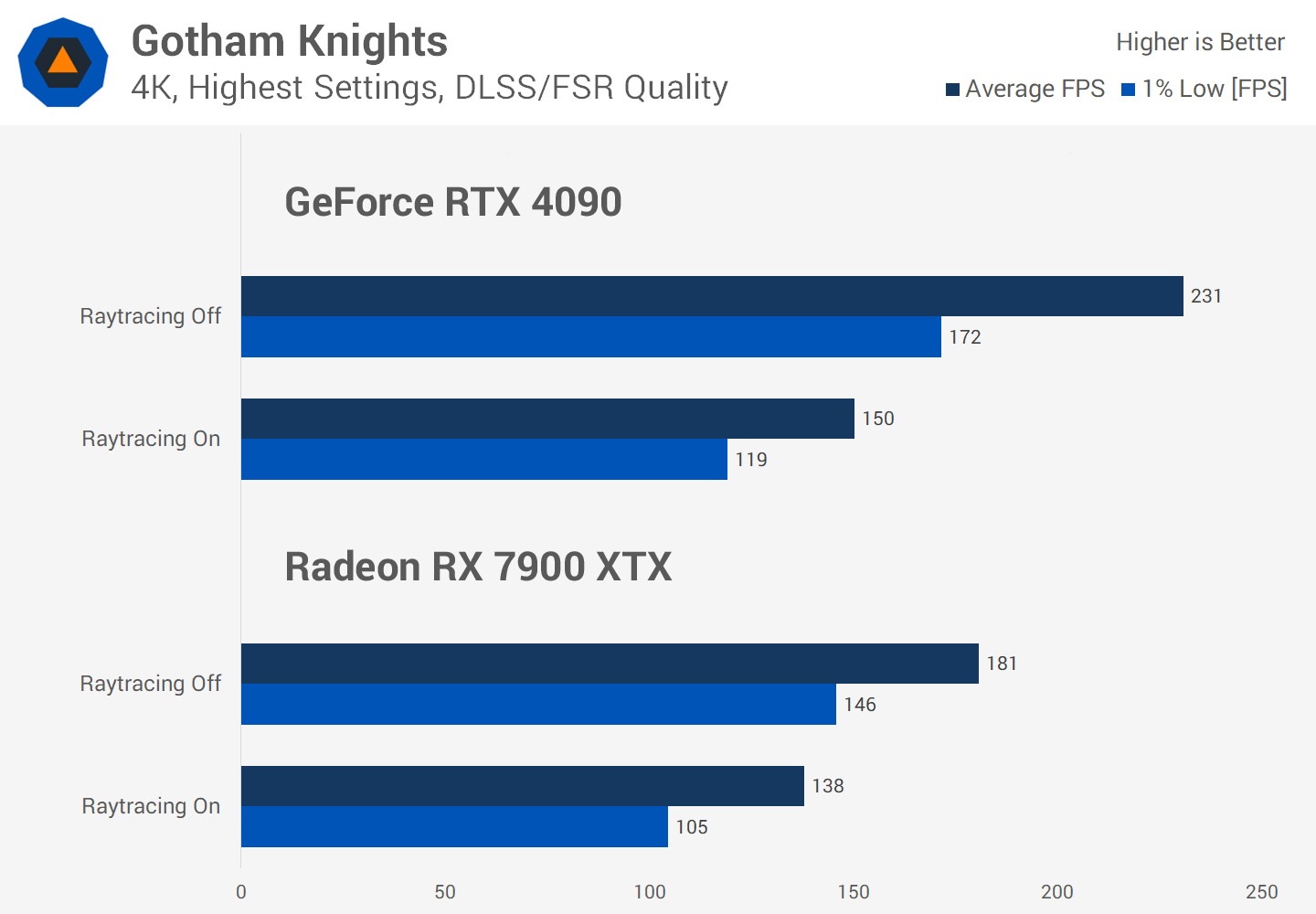
Dead Space
Dead Space uses ray-traced ambient occlusion, which has a minimal visual impact, reflected in the minor performance hit. On the RTX 4090, this effect has a negligible impact, only 3%, while on the RX 7900 XTX, it reduces the average frame rate by 12%.
This is one of the smaller impacts of enabling ray tracing, consistent with the slight visual difference.
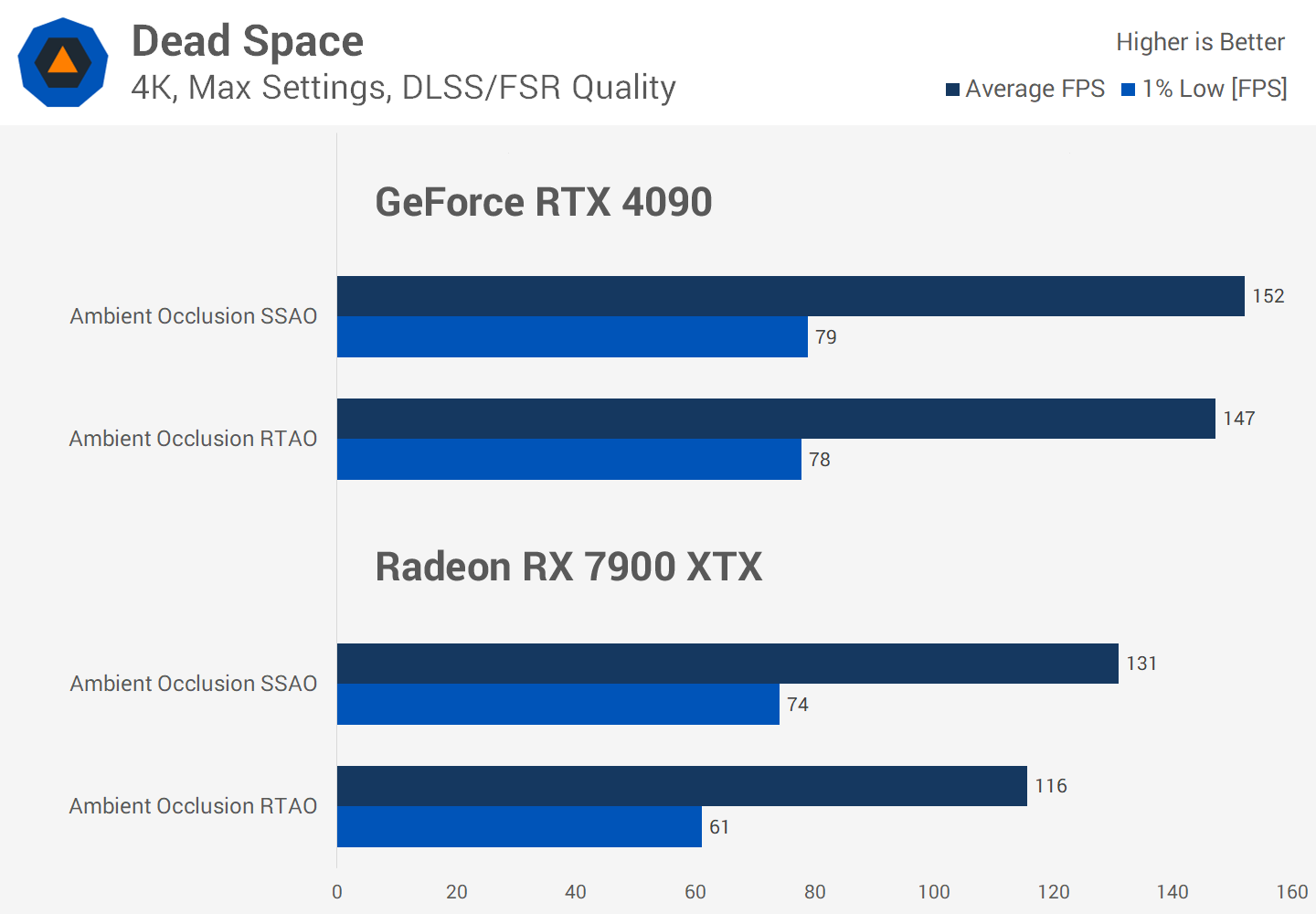
Dirt 5
In Dirt 5, distinguishing whether ray tracing is enabled or not is challenging, as the game uses ray-traced vehicle shadows. This effect lowers the frame rate by 15% on the RTX 4090 and by 19% on the RX 7900 XTX, with similar performance impact on both cards.
Although frame rates remain high with or without ray tracing, reducing performance seems unnecessary when the benefits are practically invisible.

Resident Evil 4
Resident Evil 4 incorporates fewer ray-traced effects than Resident Evil Village, making the impact less noticeable and the performance hit smaller. On the RTX 4090, enabling ray tracing at the highest settings results in just a 2% drop in average frame rates, essentially maintaining the same performance.
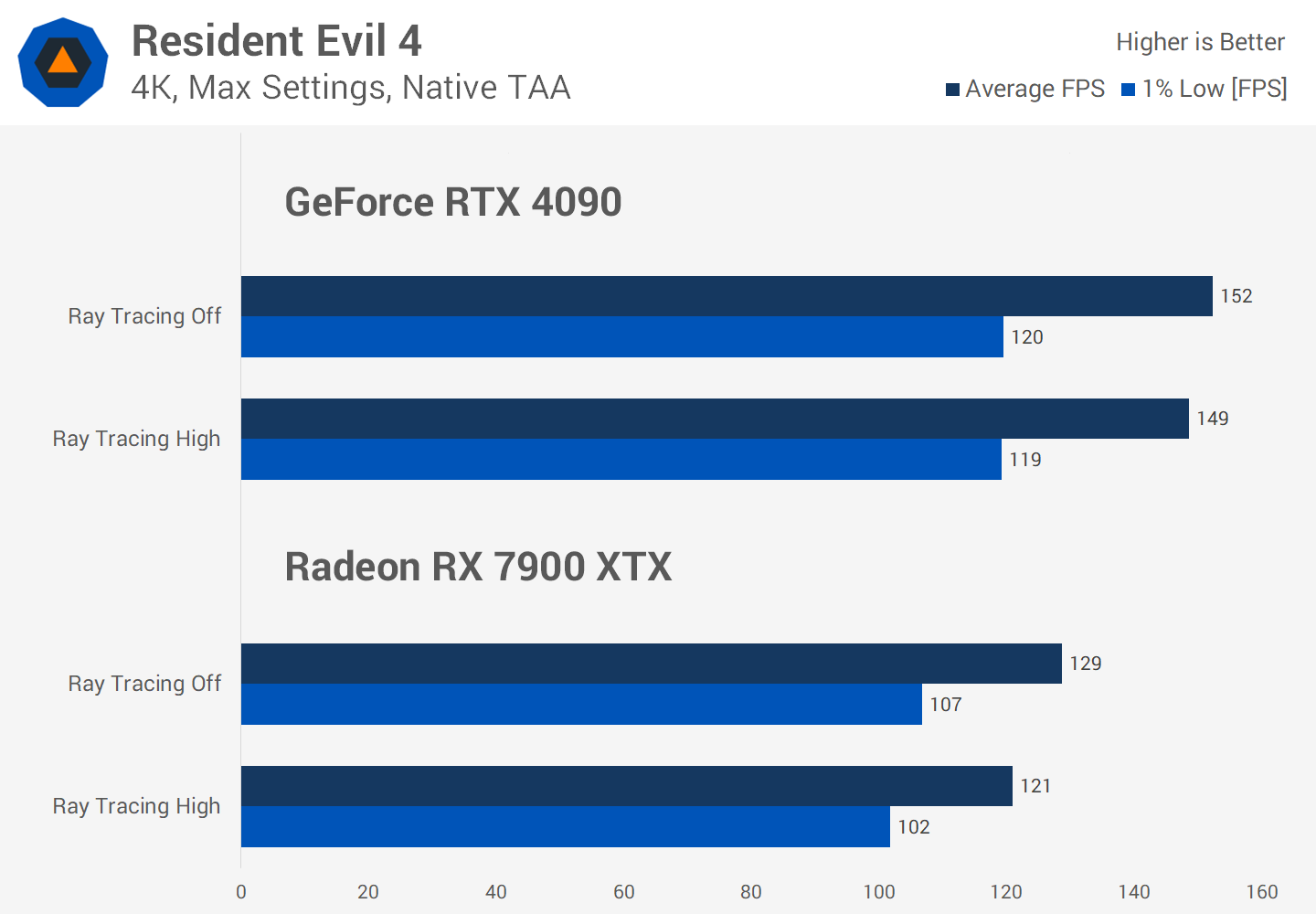
This game is also favorable for the RX 7900 XTX, with only a 6% performance drop. These are the types of games that can skew ray tracing performance averages unreasonably, as the small frame rate impact seems appealing, but the visual benefits are minimal. It’s unlikely anyone would invest in ray tracing for this title alone.
A Plague Tale: Requiem
A Plague Tale: Requiem uses ray-traced shadows that enhance visuals slightly, though only upon close inspection. In this game, the RTX 4090 sees an 18% hit to the average frame rate with ray tracing enabled, while the RX 7900 XTX experiences a much greater 39% drop.
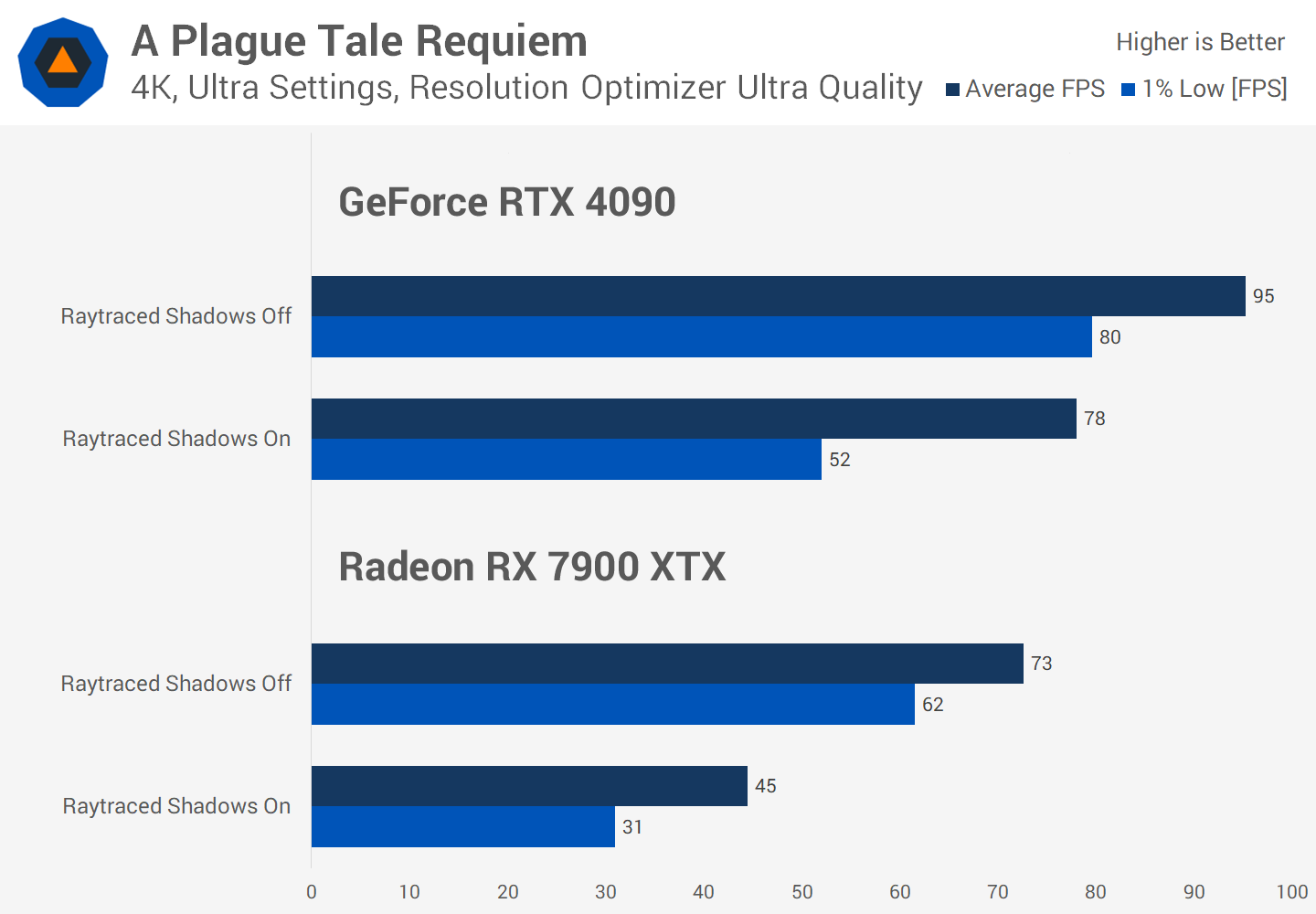
Consequently, while the RTX 4090 is 31% faster with ray tracing disabled, its lead extends to an impressive 75% when ray tracing is enabled – though the game looks excellent even without it.
Far Cry 6
Far Cry 6 makes minimal use of ray tracing, despite including ray-traced shadows and reflections. On the RTX 4090, this leads to a modest 13% performance drop, and a 19% drop on the RX 7900 XTX. This does not notably alter the performance comparison between GeForce and Radeon, as both cards still deliver relatively close performance levels.
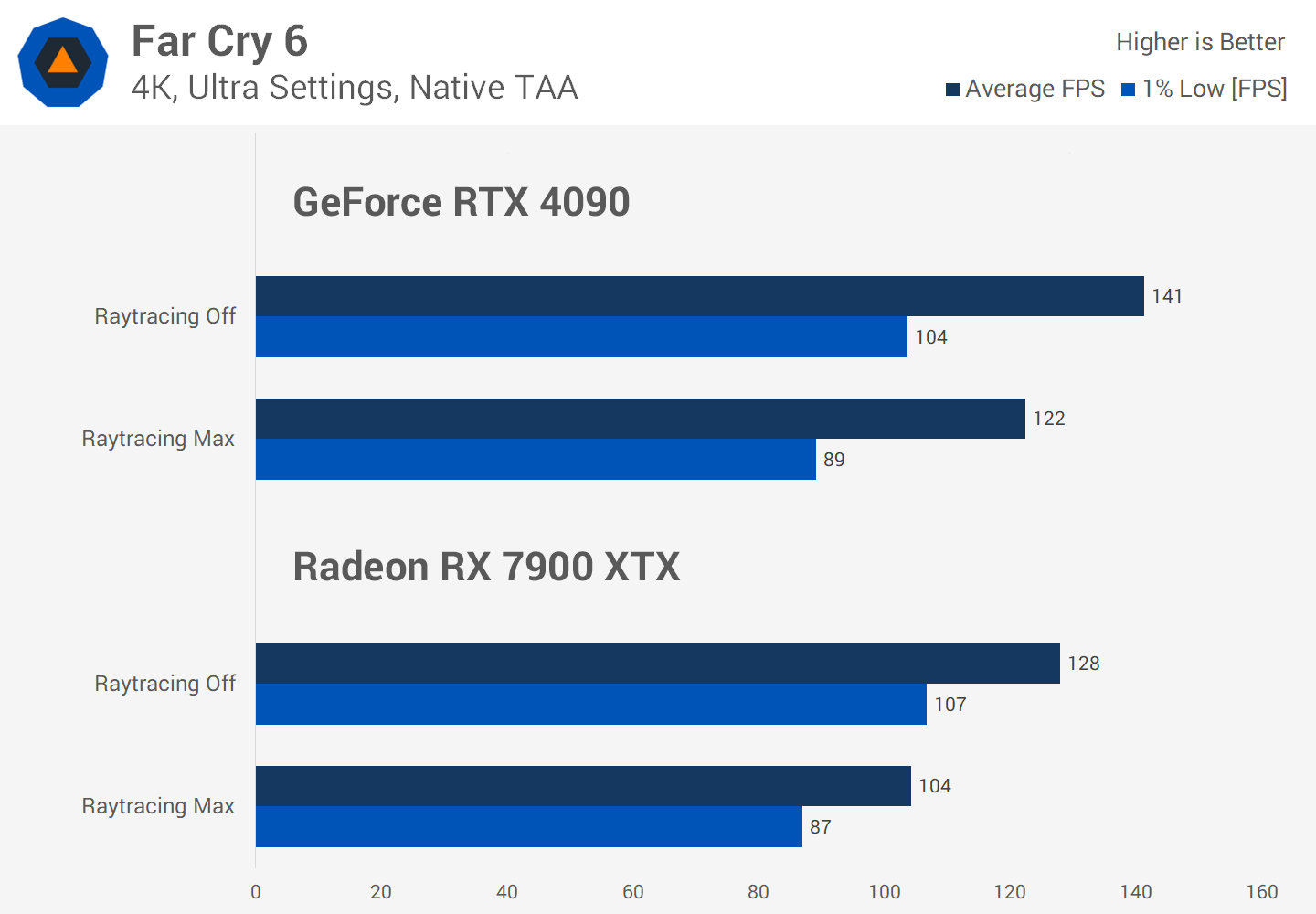
Battlefield 2042
Battlefield 2042 is a multiplayer title that features a ray-traced ambient occlusion implementation with little practical benefit.

Enabling this setting reduces frame rates by 17% on the RTX 4090 and by 27% on the RX 7900 XTX, severely affecting one-percent lows. There’s little reason to enable this setting, especially as it pushes the 7900 XTX below 120 FPS at 4K.
F1 24
F1 24 incorporates more ray tracing effects than any previous F1 game, tested here with all ray tracing settings enabled at either medium or high quality. Medium quality results in a relatively modest performance hit of 24% on the RTX 4090 and 29% on the RX 7900 XTX.

High quality increases this impact significantly, with a 41% drop on the 4090 and a 51% drop on the 7900 XTX, meaning the frame rate on the Radeon GPU is effectively halved at maximum in-game ray tracing settings. One-percent lows are even more impacted, making ray tracing difficult to recommend for this game.
Interestingly, despite the extensive effects used, the game is reasonably well-optimized for both GPU brands. With ray tracing disabled, the 4090 is 31% faster than the 7900 XTX, a lead that extends to 39% with medium ray tracing and to 57% at high settings, indicating a slightly larger gap at the highest settings.
Forza Motorsport
While ray tracing in Forza Motorsport may offer minor visual improvements, enabling car reflections is something worth considering. On both the RTX 4090 and RX 7900 XTX, this setting has a minimal performance impact, similar to many rasterization settings.
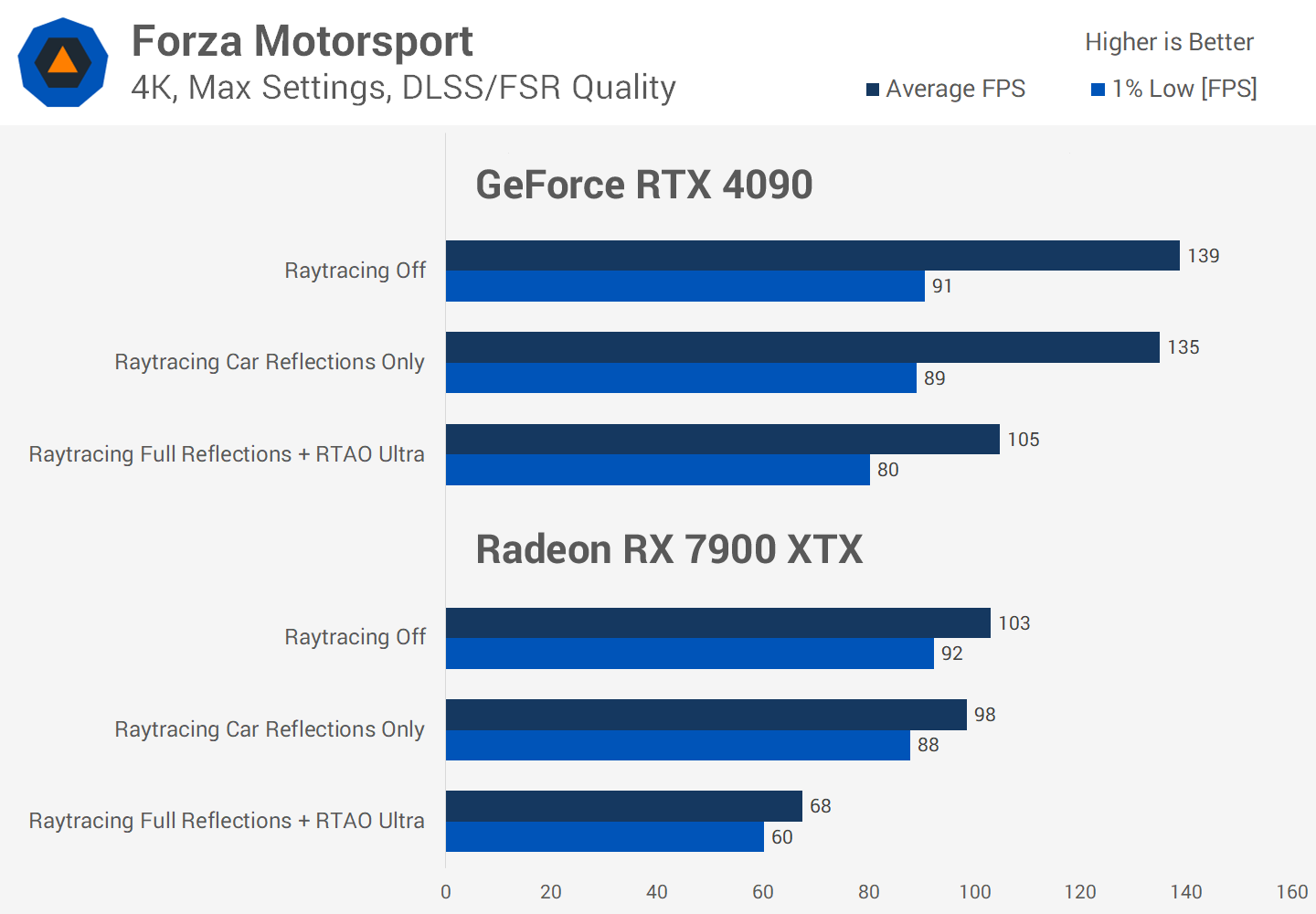
However, enabling all ray tracing effects noticeably reduces frame rate, with a 24% hit on the RTX 4090 and a 34% hit on the 7900 XTX. Comparatively, the 4090 is 37% faster with only car reflections enabled but becomes 55% faster when more extensive ray tracing is applied.
Fortnite
Using hardware ray tracing in Fortnite doesn’t notably impact performance or visuals. The RTX 4090 sees just a 6% frame rate reduction with hardware RT, while the 7900 XTX experiences an 8% drop.

Overall, the game tends to favor GeForce hardware when all effects are maximized and Lumen is enabled, whether through software or hardware paths.
The Callisto Protocol
In The Callisto Protocol, medium ray tracing settings detract from visual quality, showing minimal gains even at the highest settings. Medium ray tracing settings lead to around a 35% performance drop on both the RTX 4090 and RX 7900 XTX.

When all settings are maxed out, both GPUs experience a 45% performance loss. This is a rare case where ray tracing has a similar impact on both Ada Lovelace and RDNA3 architectures, although the visual improvement remains minor, even at maximum settings.
Deathloop
Deathloop uses ray tracing primarily for shadows, altering the visual presentation but not necessarily improving it. The performance impact on the RTX 4090 is minimal at just 4%, but the 7900 XTX suffers more significantly, with a 25% average frame rate drop.
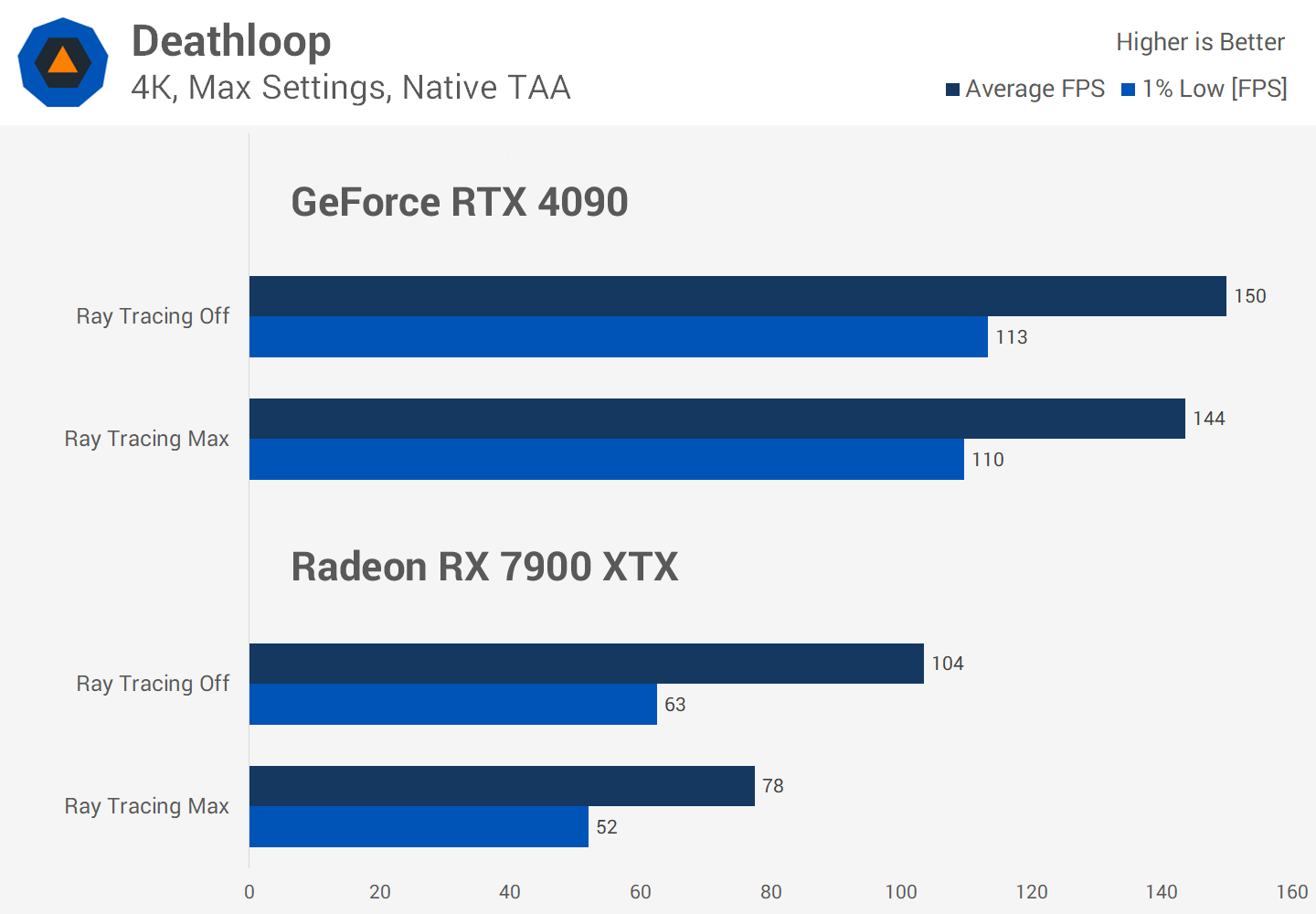
This difference means the RTX 4090 is 45% faster with ray tracing disabled, increasing to 85% faster with ray tracing enabled – a substantial disparity given the minimal visual benefit.
Forspoken
In Forspoken, ray tracing performance impacts are similar on both GeForce and Radeon, averaging around 15%. This game slightly favors Radeon hardware overall, but it doesn’t stand out as an example of ray tracing significantly enhancing visual quality.

Dragon’s Dogma II
Like Deathloop, Dragon’s Dogma II alters its visual presentation with ray tracing, though the improvement isn’t always noticeable. Enabling ray tracing reduces frame rate by 18% on the RTX 4090 and 16% on the RX 7900 XTX, making this another relatively favorable outcome for Radeon. This was with DLSS and FSR enabled on the respective cards.
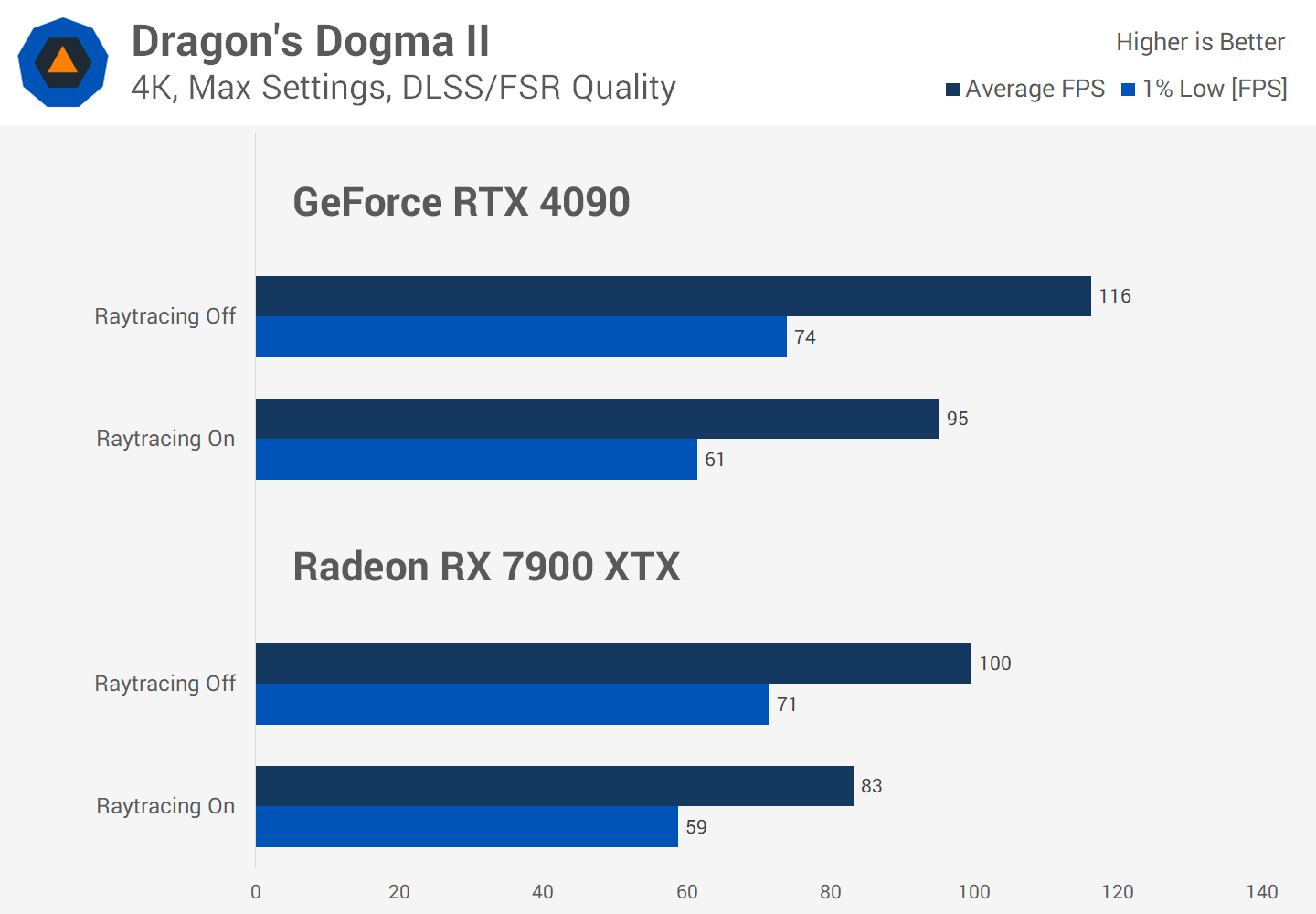
Diablo IV
In Diablo IV, ray tracing has a limited visual impact, but the performance hit is surprisingly high. With all settings enabled but set to low, there’s a 28% FPS reduction on the RTX 4090 and a 36% drop on the RX 7900 XTX.
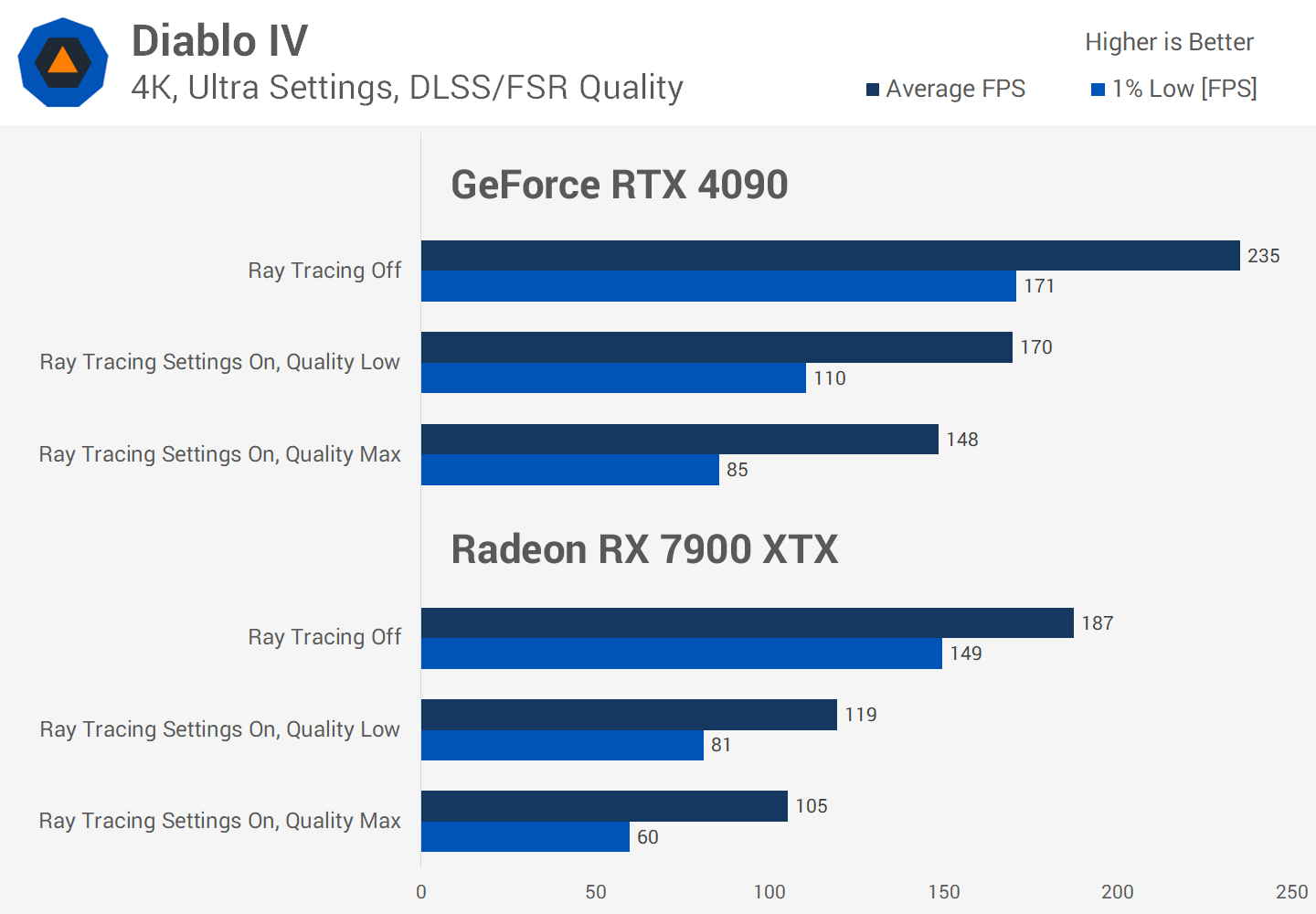
With settings maxed, the impact increases to 37% on the 4090 and 44% on the 7900 XTX. While performance with ray tracing enabled remains playable, it shifts the 4090’s advantage from 26% faster than the 7900 XTX without ray tracing to 41% faster with ray tracing at maximum settings.
Shadow of the Tomb Raider
Shadow of the Tomb Raider is one of the earlier ray tracing implementations, using ray-traced shadows that are still highly taxing. On the RTX 4090, enabling Ultra ray tracing results in a 32% performance drop, while the 7900 XTX experiences a larger 44% reduction. Given the modest visual improvement, most gamers are unlikely to find this performance trade-off worthwhile.

Star Wars Jedi: Survivor
Star Wars Jedi Survivor also fell into the category of ray tracing changing the way the game looks without clearly improving visuals. Both the RTX 4090 and RX 7900 XTX were impacted to a similar degree, with a 23% drop on the 4090 and 21% drop on the 7900 XTX.

This is another title where overall performance is quite favorable to Radeon, with the 4090 being less than 20% faster, whether ray tracing is enabled or disabled.
Atomic Heart
We don’t think the developers of Atomic Heart tried very hard to optimize the performance of ray tracing in this game. Enabling even the Performance settings, which look significantly worse as they strip out many reflections, absolutely tanks performance, halving the frame rate even on the RTX 4090.

The performance hit isn’t that much higher using the Quality mode, so obviously you would never consider using the Performance mode. With ray tracing disabled, the RTX 4090 is 45% faster than the 7900 XTX, and with maximum ray tracing, it’s 51% faster, so not a huge discrepancy there despite the massive performance cost.
Hogwarts Legacy
Hogwarts Legacy could have benefitted from higher resolution reflections, though at times, ray tracing can make the game look more impressive. When looking at these performance numbers, you can see why the developers were a bit conservative with ray tracing quality: the Ultra mode caused a 45% performance hit relative to not using ray tracing on the RTX 4090 and a 58% hit on the 7900 XTX.

Even on the much less impressive Low configuration, with all ray traced effects enabled, the performance hit was still pretty large at 30% on the GeForce card and 48% on Radeon. Whether you use ray tracing or not completely changes the margins between these cards: a 16% performance advantage for the 4090 with RT disabled, but a whopping 52% lead when ray tracing is set to Ultra.
Hitman 3
We had mixed feelings about the visual benefits of ray tracing in Hitman 3, and unfortunately, the performance cost makes it difficult to justify using.
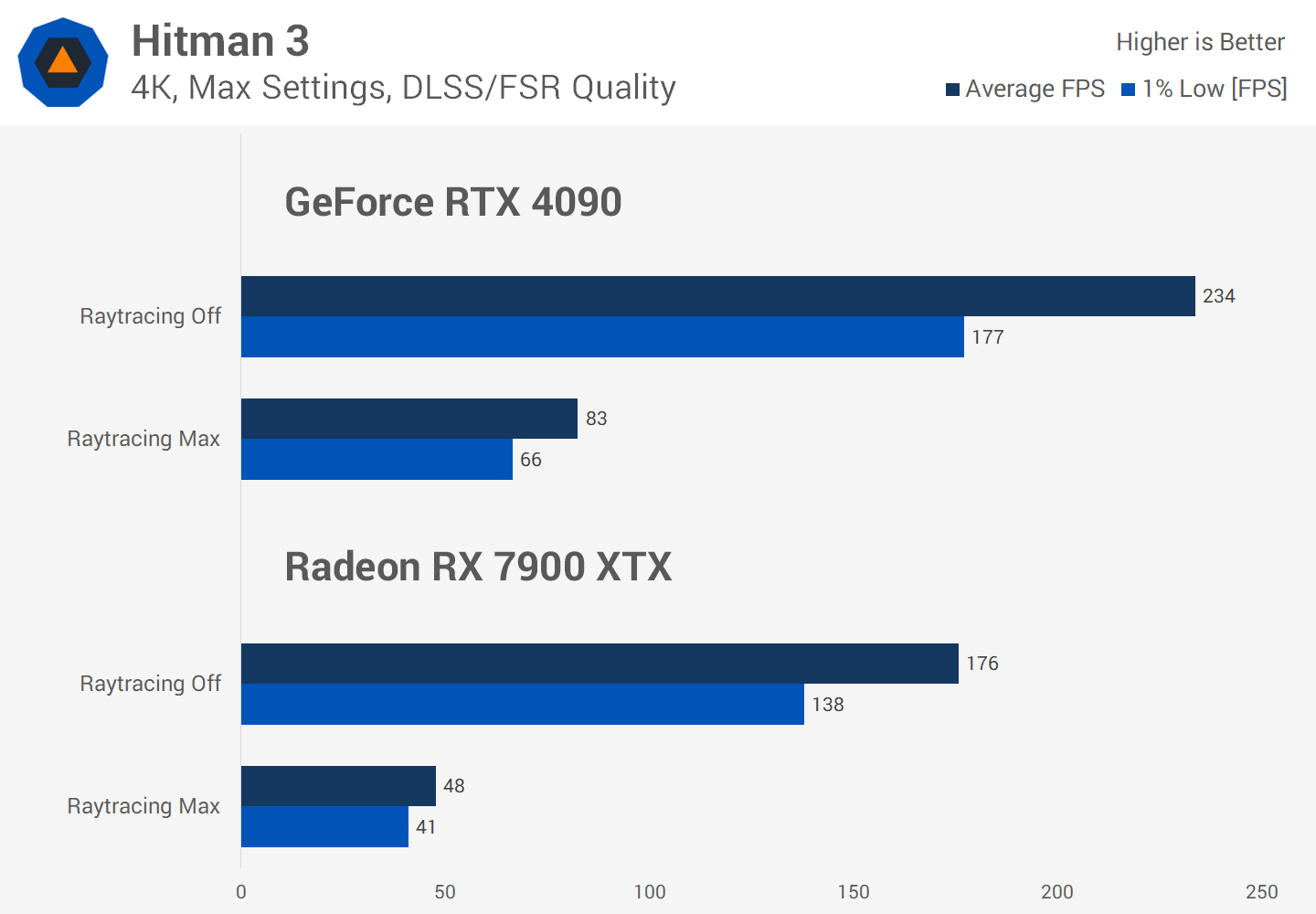
This is one of the most performance-intensive implementations we’ve seen: turning on max ray tracing saw a 65% hit to performance on the RTX 4090, taking the average frame rate from 234 FPS to just 83 FPS at 4K using DLSS Quality.
Performance is slaughtered on the RX 7900 XTX, a 73% reduction from 176 FPS to just 48 FPS on average. While the RTX 4090 ends up 73% faster with ray tracing enabled, either way, you look at it, this is a huge impact that’s hard to recommend.
Suicide Squad: Kill the Justice League
Suicide Squad Kill the Justice League’s implementation of ray traced reflections is beneficial on some surfaces, but this results in a 38% performance loss on the RTX 4090, and performance is halved on the RX 7900 XTX. We wouldn’t say this is unusual for RT reflections, but it’s certainly a large hit.
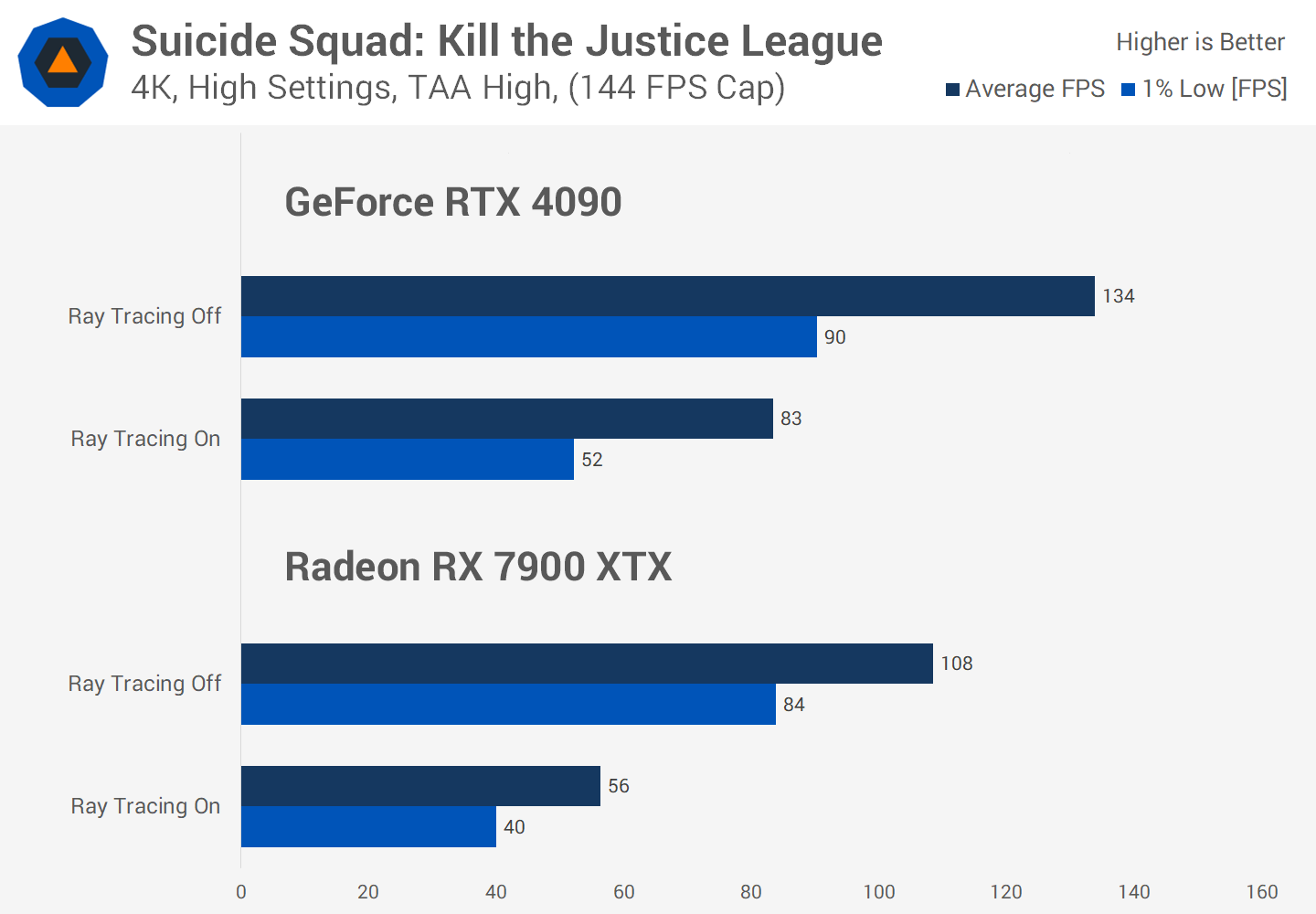
Doom Eternal
Doom Eternal is in a similar position. In the area we benchmarked, enabling ray tracing led to a 35% performance loss on the RTX 4090 and a 48% loss on the 7900 XTX.
This isn’t a devastating impact on the 4090 because the frame rate dropped from a huge 293 FPS to 189 FPS, which is still very playable, but on the 7900 XTX, the ray tracing configuration delivered 127 FPS, making the 4090 around 49% faster.
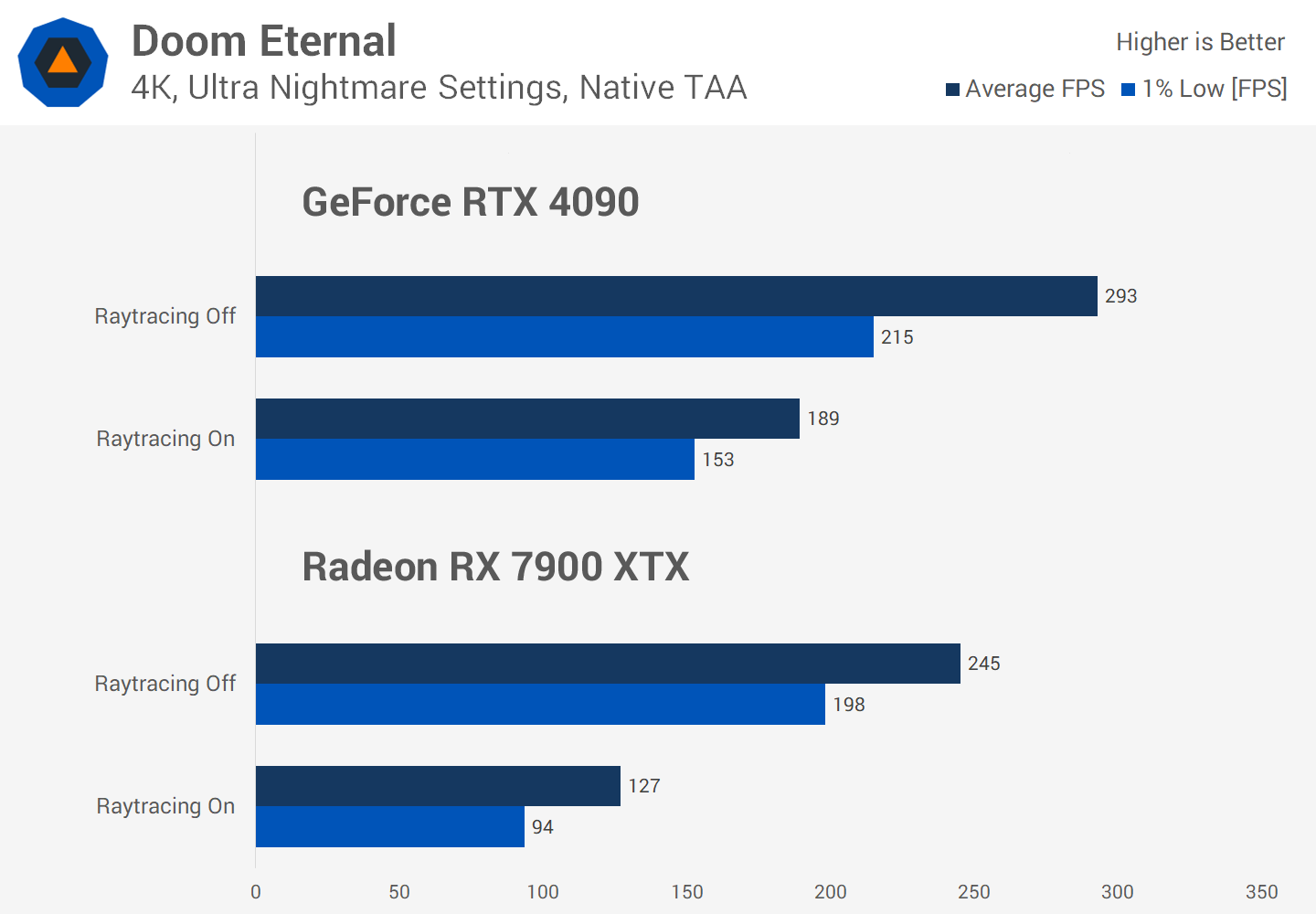
This isn’t a situation where the 7900 XTX is hopeless at ray tracing – again, still playable – but the 4090 is quite a bit better.
Marvel’s Guardians of the Galaxy
Ray tracing in Guardians of the Galaxy is worth enabling, even on the lowest configuration, which is with ray traced reflections set to High. In this mode, the 4090 lost just 14% of its performance, while the 7900 XTX saw a 23% drop – not a small hit, but manageable for higher-quality reflections.
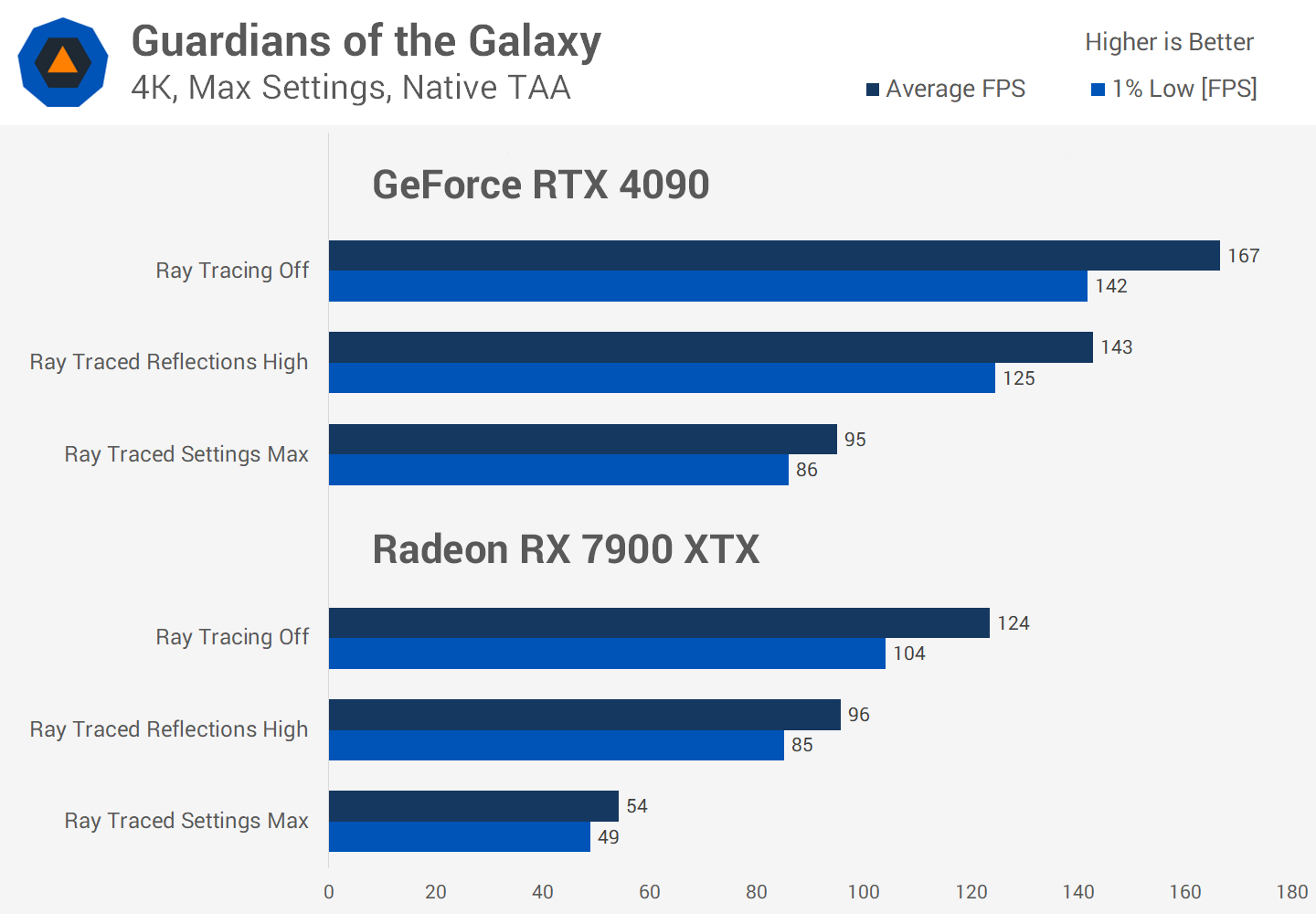
When cranking everything up, though, you’re left with a 43% hit on the 4090 and a 56% hit on the 7900 XTX. This means the 4090 goes from being 35% faster than the 7900 XTX with ray tracing off, to 49% faster on the lowest configuration, to 76% faster on the highest configuration. The more ray tracing you ask a game to do, the more this hurts the position of Radeon vs GeForce.
Ratchet & Clank: Rift Apart
As far as ray tracing configurations go, we think Ratchet & Clank Rift Apart is quite well optimized relative to other implementations. With both the reflection and shadow effects enabled but set to their lowest level, the RTX 4090 sees just an 18% performance hit, and 28% with everything cranked up to maximum.
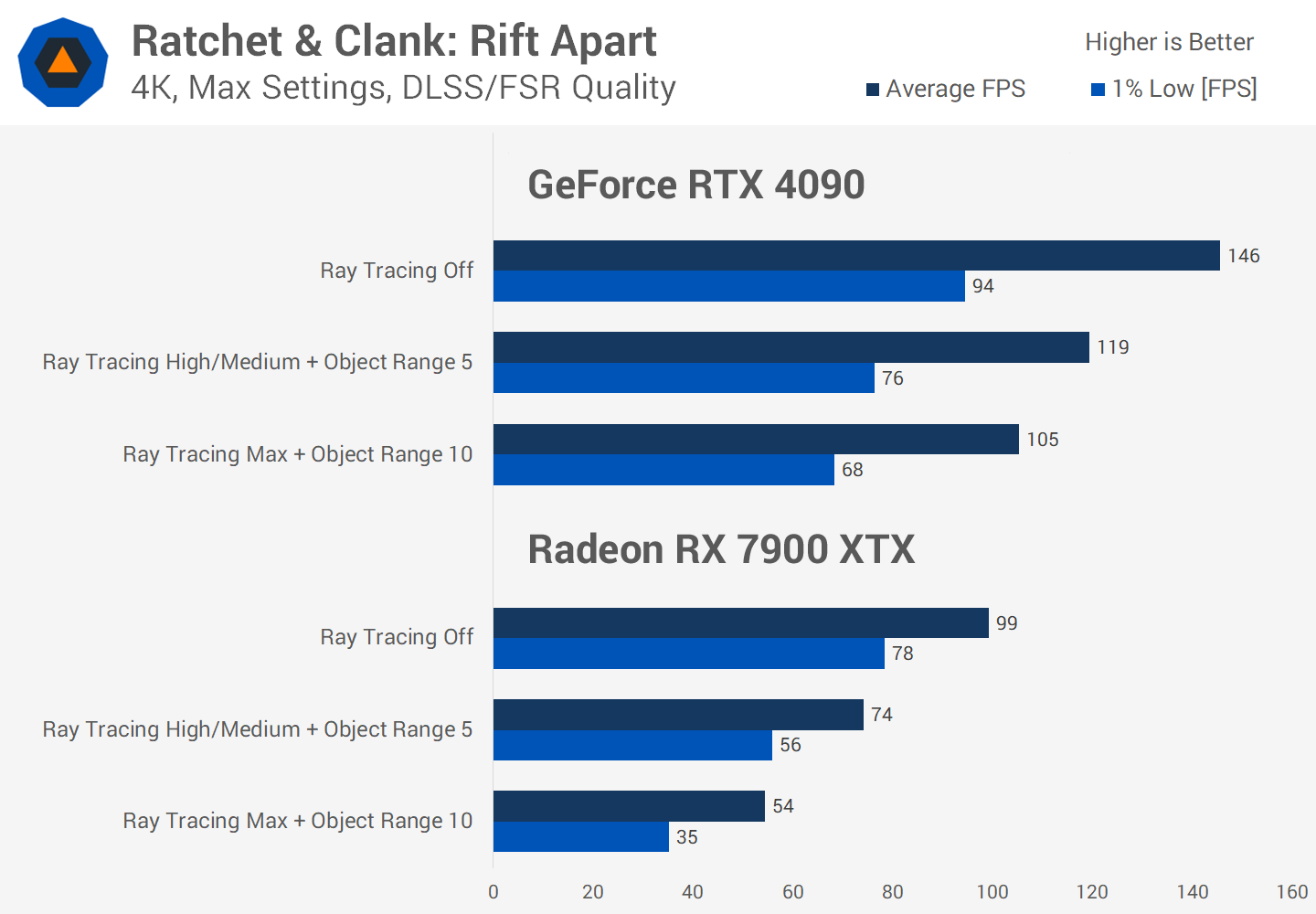
The impact is larger on the RX 7900 XTX at 25% on the lowest level, and 45% on the highest level. But compared to a game like Hogwarts Legacy or Hitman 3, we think the ray tracing in Rift Apart looks better at a lower performance cost, and especially on the 4090, the game is very playable with everything set to the highest level.
However, comparing GeForce to Radeon, this is a title that strongly favors the RTX 4090. Even with ray tracing disabled, the RTX 4090 was 47% faster, and this grew to a 61% lead with minimum level ray tracing, and performance was nearly double on the highest settings.
Ghostwire: Tokyo
Ghostwire Tokyo is one of the earlier implementations of ray traced reflections, and in this game, cranking everything up to a level we feel is worth using (so everything on High) caused a 44% performance hit on the RTX 4090 and a 58% hit on the 7900 XTX. Like in Ratchet & Clank, this significantly extends an already large performance lead in favor of team green.
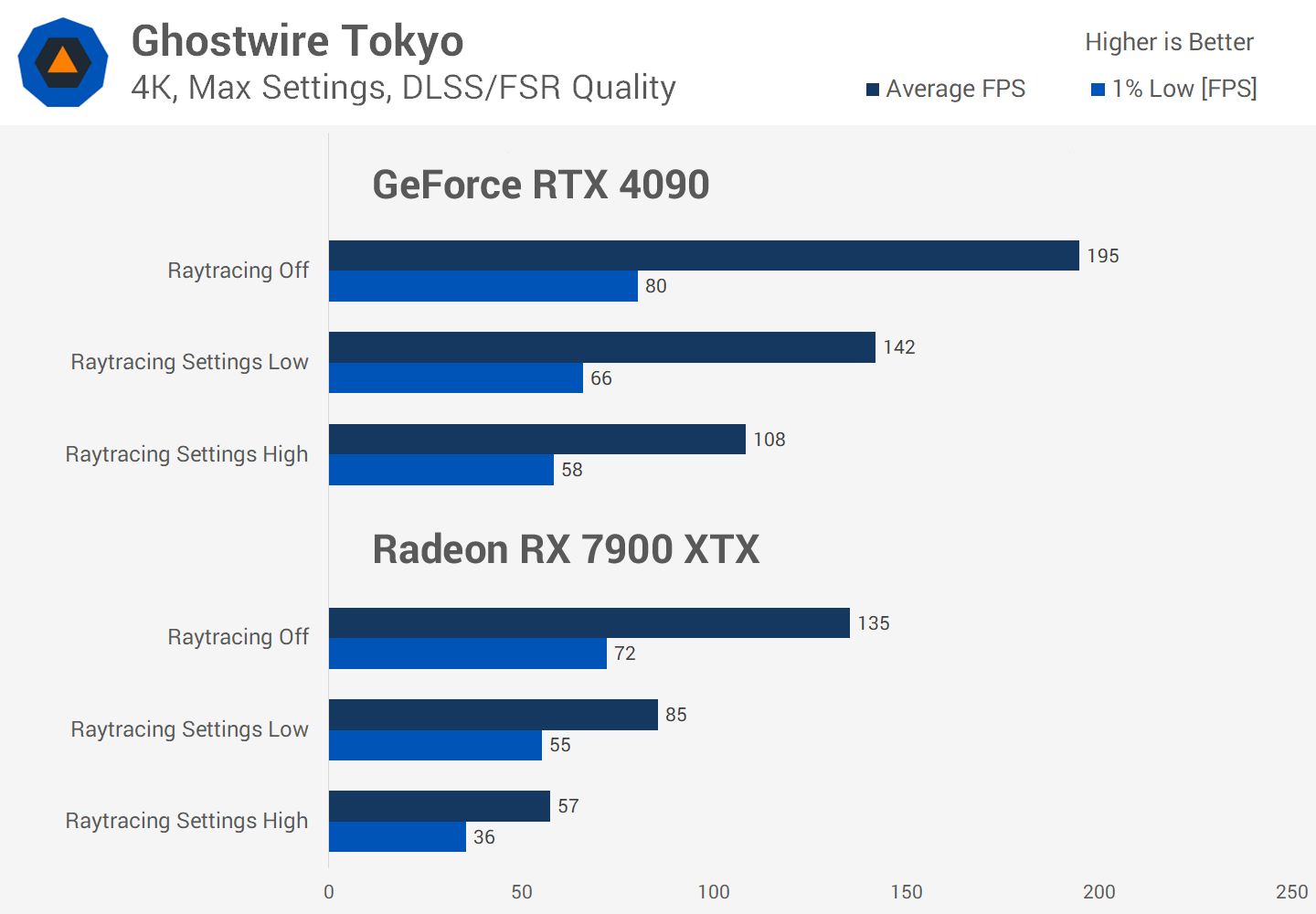
Watch Dogs: Legion
Watch Dogs Legion is a pretty straightforward situation of ray traced reflections. On the medium mode, which is the lowest ray traced settings, the 4090 sees a 43% performance hit and 47% using the highest Ultra settings, so you may as well use Ultra if you are going to enable ray tracing.
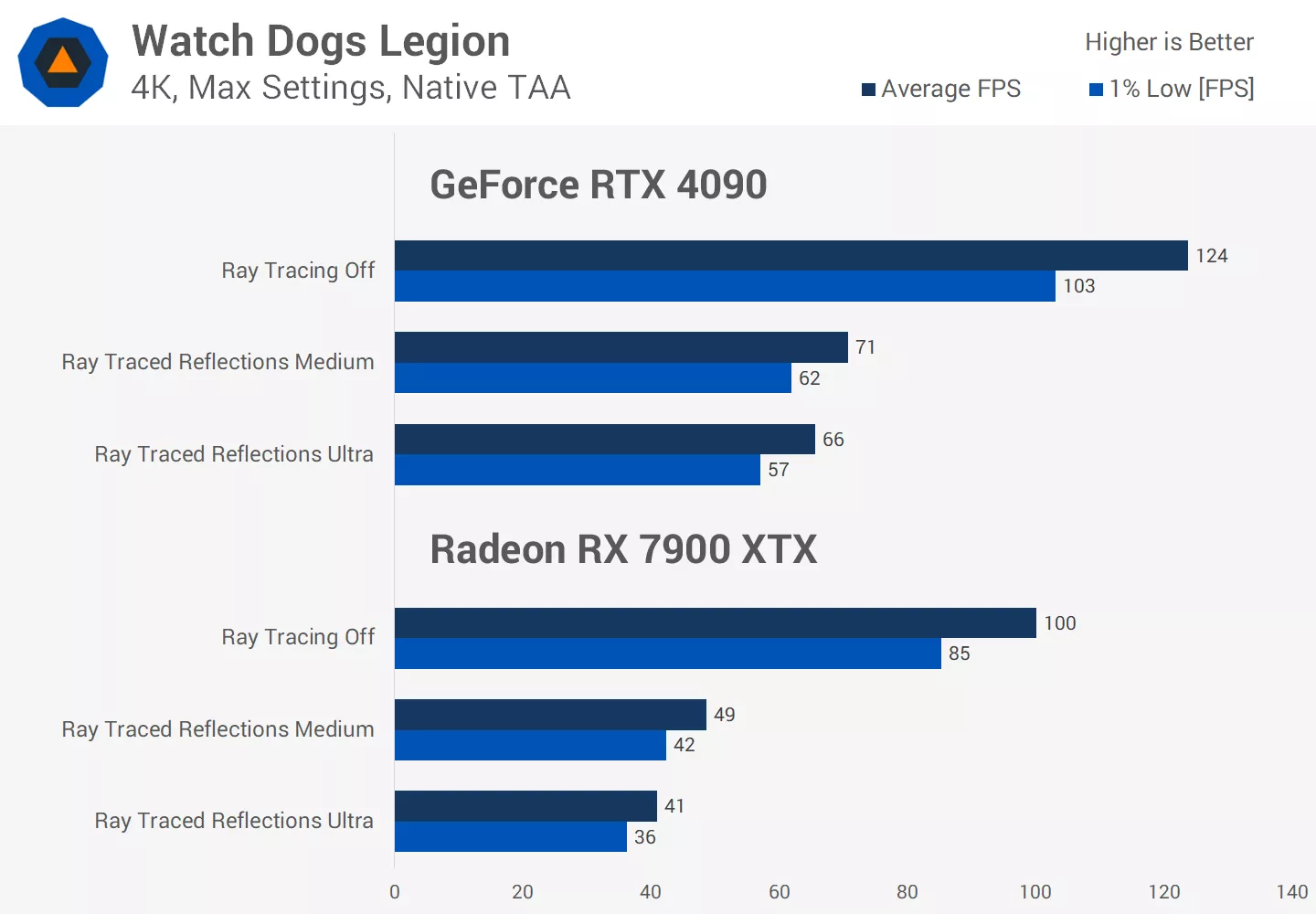
The 7900 XTX sees performance at least halved, or slightly more than halved on Ultra. Again, this takes a 25% lead for the 4090 without ray tracing and boosts it to a 60% lead on Ultra level ray tracing.
The Witcher 3: Wild Hunt
Retrofit with ray tracing seven years after release, The Witcher 3 Wild Hunt is quite performance-intensive on the Ultra+ preset. Turning on ray traced global illumination to the performance mode saw a 29% performance hit on the RTX 4090 and a similar 27% hit on the 7900 XTX.
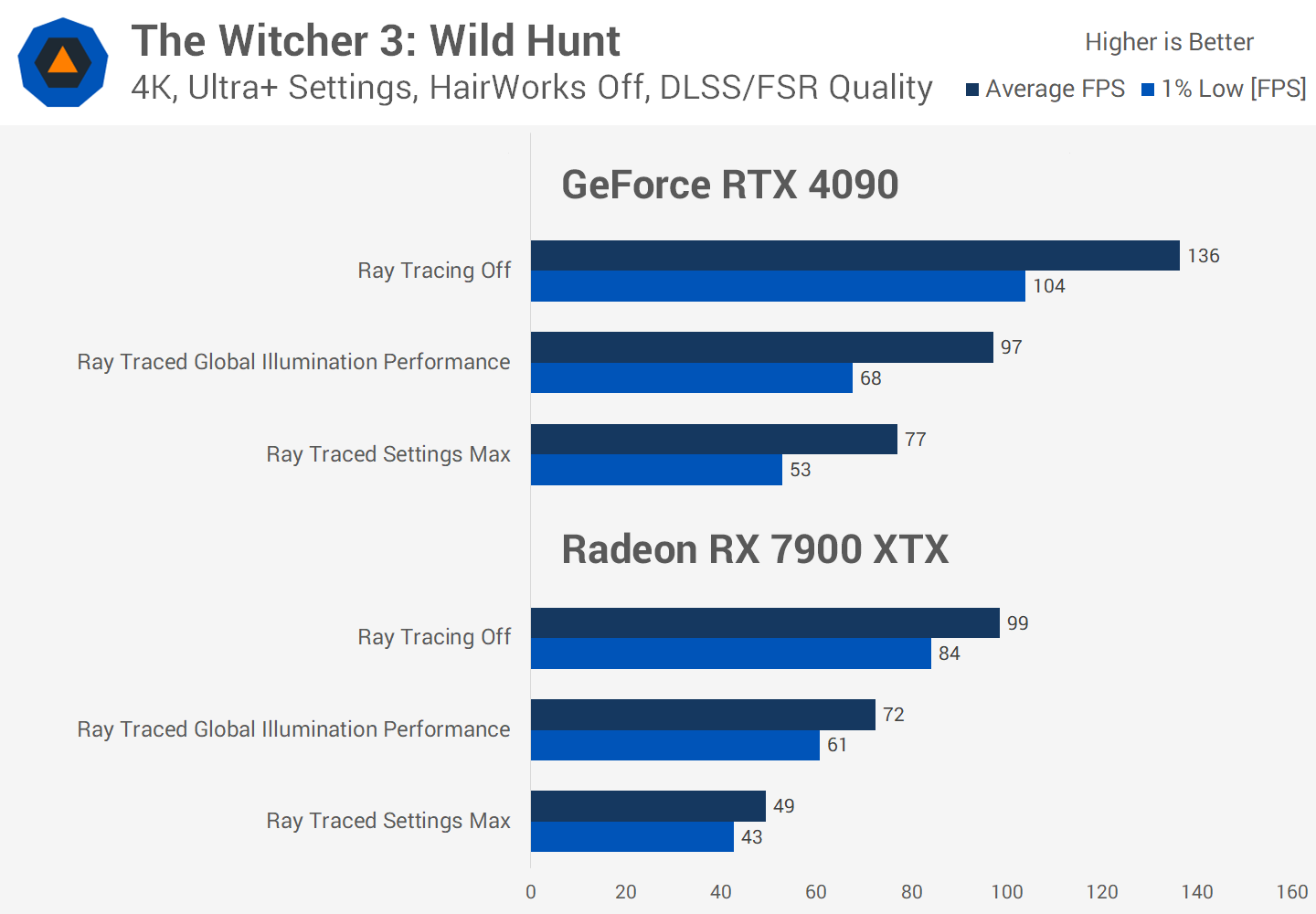
With everything cranked up to the maximum settings, performance halved or thereabouts on both GPUs. Despite being an Nvidia-sponsored title, this isn’t the worst example of ray tracing performance differences between GeForce and Radeon, though in general, this title performs better than average on the 4090.
Control
Another early example of ray tracing is Control. The RTX 4090 is actually capable of 60 FPS at native 4K using the high ray tracing preset, though this is a 39% performance loss relative to disabling ray tracing. The impact is even larger on the 7900 XTX, where the frame rate is halved. This leads to the RTX 4090 being around 50% faster when some form of ray tracing is enabled.
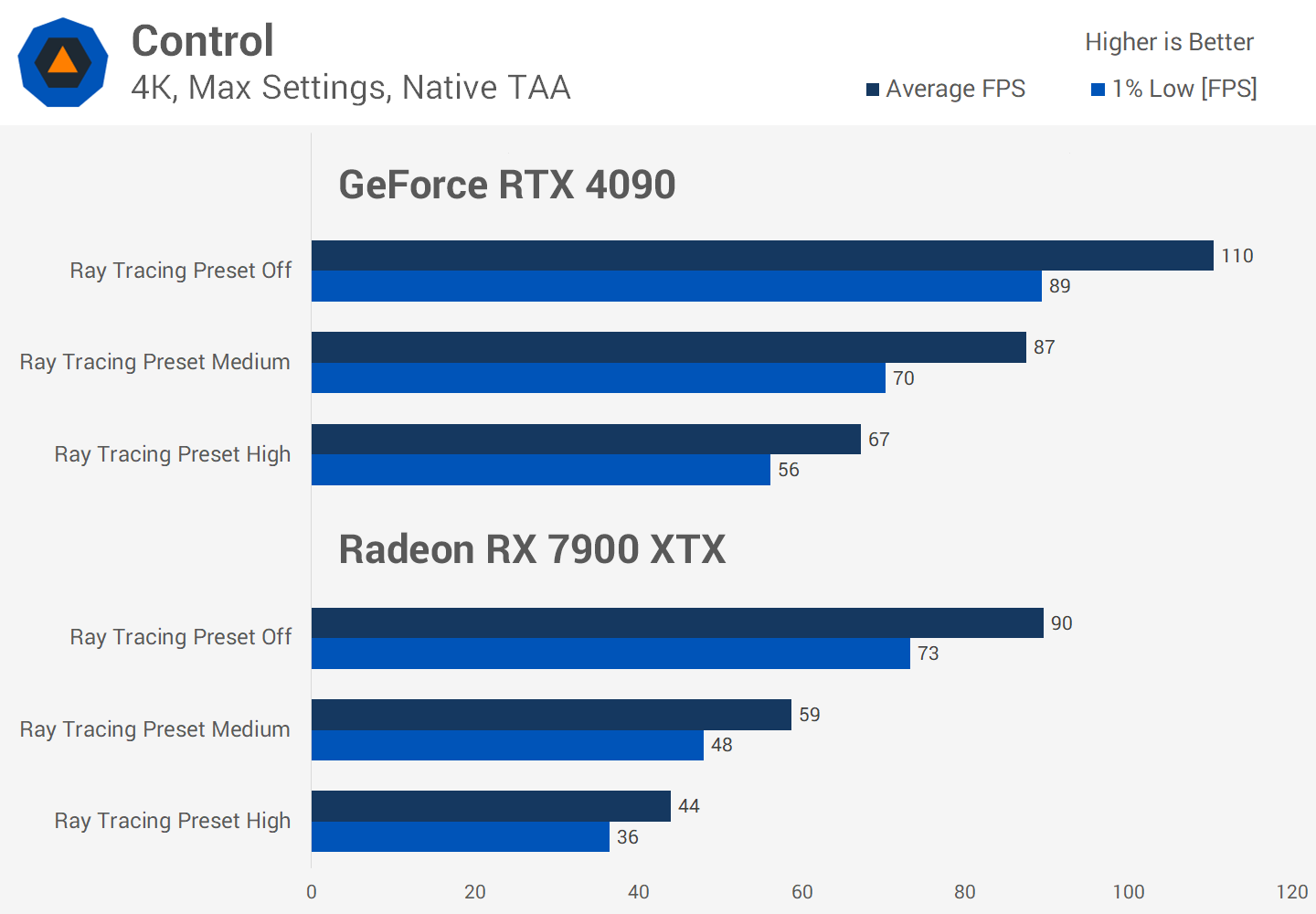
Dying Light 2
It’s generally worth using ray tracing in Dying Light 2 from a visual standpoint, but only on the High Quality preset, as the standard “Raytracing” mode doesn’t impact the presentation that much.
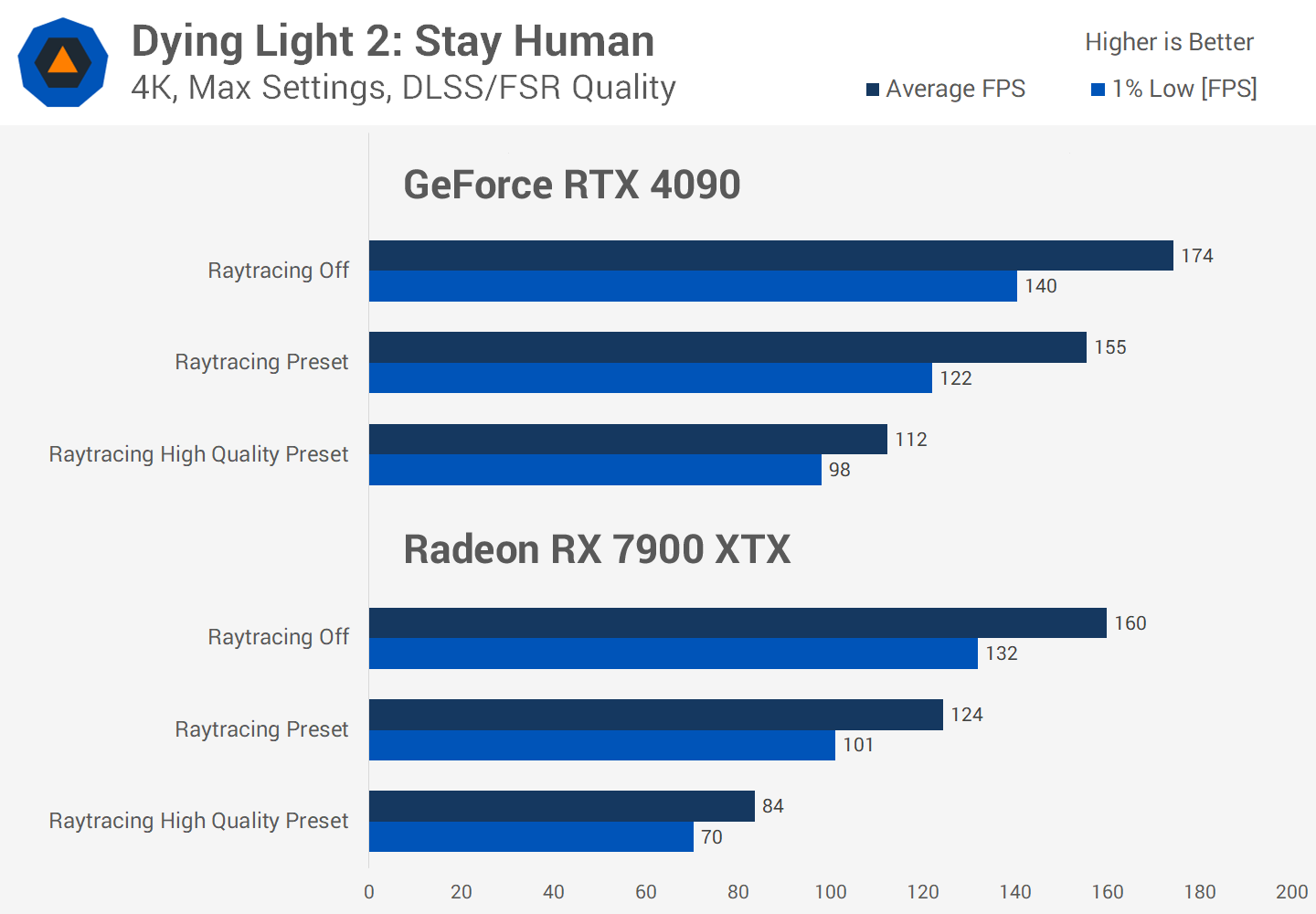
And you can see that in the performance cost on the RTX 4090, where everything maxed out sees a 36% performance hit, but just an 11% hit when using the lower quality mode. Again, the impact is larger on the 7900 XTX, where the best visuals will see your performance halved, resulting in a 34% performance lead to the RTX 4090.
Spider-Man
Spider-Man is relatively well optimized for both GPU brands, although enabling ray traced reflections does come with a hefty performance cost on the highest settings. Still, in this title, the RTX 4090 is only around 12% faster than the 7900 XTX even with ray tracing fully enabled, so that’s quite a favorable result for Radeon relative to most other results.
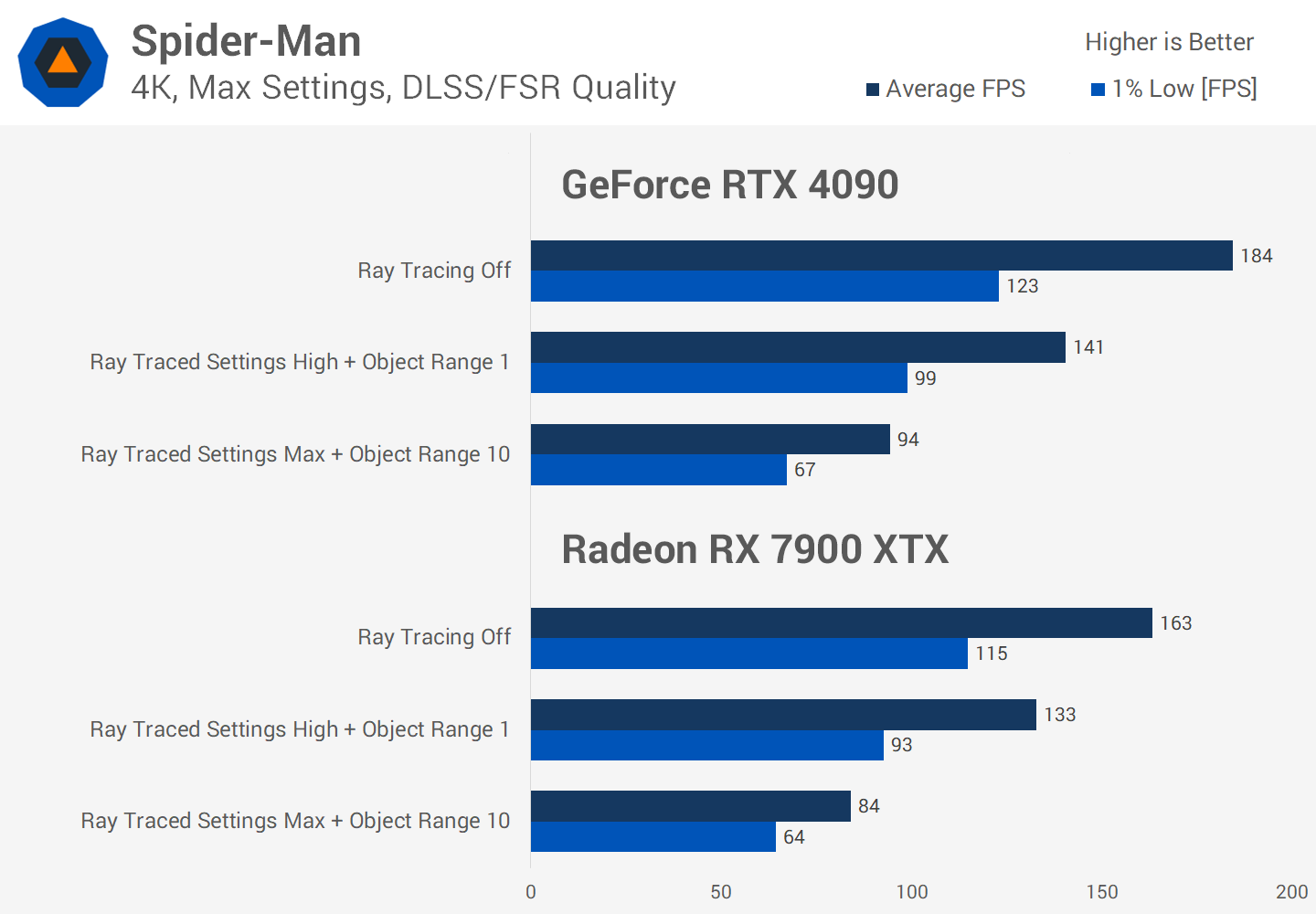
Spider-Man: Miles Morales
Spider-Man Miles Morales adds in ray traced shadows, though again there isn’t a massive discrepancy in ray tracing performance hits between GeForce and Radeon. With everything set to the highest level, we’re still looking at performance being halved relative to otherwise maximum settings; in this instance, the RTX 4090 is 24% faster with maximum ray tracing.

Metro Exodus
Metro Exodus is a really interesting example because we have both the base game and the “Enhanced Edition.” When looking purely at the base game, it’s a simple story: maximum ray tracing causes a 30% performance hit on the RTX 4090 and a 42% hit on the RX 7900 XTX.

But there’s little reason to use that configuration if you want to play the game, because the Enhanced Edition actually runs better while featuring improved visuals, too. Just a 10% hit relative to the base game without ray tracing to use the lowest level of Enhanced Edition RT settings on the 4090, and a 16% hit on the 7900 XTX. That’s pretty manageable.
Maximum settings see just a 24% hit on the 4090 and a 39% hit on the 7900 XTX, in both instances performing better than the base game on ultra ray tracing.
Overall, the game is quite favorable to GeForce hardware. Even the base game is 49% faster on the RTX 4090 vs. RX 7900 XTX, and this increases to 61% using the Enhanced Edition on minimum ray tracing or 85% on max ray tracing.
Black Myth: Wukong
Lastly, we get to the three path-traced titles, which generally have among the biggest visual improvements. Black Myth Wukong runs really well on the RTX 4090, so using Very High Full Ray Tracing only causes a 41% performance loss versus the Cinematic preset.

That’s not overly different from other ray-traced effects in other titles. But on the RX 7900 XTX, this absolutely cripples performance, with a 64% performance loss on the Low mode and 83% on Very High, taking the game into the single-digit FPS range.
This makes Black Myth Wukong much faster on the RTX 4090. It’s already 53% faster than the 7900 XTX without ray tracing, but enabling path tracing leads to the 4090 being at least 3.5x faster: 59 FPS vs. 17 FPS. The level of hardware acceleration available on the 7900 XTX is just not sufficient for this technique, although it was developed by Nvidia and optimized for their hardware.
Alan Wake 2
In Alan Wake 2, it’s a similar story. The performance cost of ray tracing is pretty normal on the RTX 4090: a 38% hit on Low settings and a 52% hit on High settings. On the 7900 XTX, this is a 50% hit on Low settings and a whopping 82% hit on High settings. While Low is maybe borderline usable with more upscaling involved, High cripples the Radeon card.

Comparatively, we see a 31% performance gain for the 4090 vs. 7900 XTX with ray tracing disabled, a 63% gain with ray tracing on Low, and a massive 259% gain on High ray tracing. Given Alan Wake 2 is one of the best-looking games on PC with path tracing enabled, this is one area AMD really needs to focus on with future architectures.
Cyberpunk 2077
Then there’s Cyberpunk 2077, where the Ultra and Overdrive settings are the most usable. The Ultra setting is surprisingly performant on the RTX 4090, leading to just a 22% performance loss. Path tracing runs reasonably well, too, considering the visual gains, halving performance, which is actually a better result than games like Hitman 3 that don’t use path tracing.

The impact is much higher on the RX 7900 XTX, where even Ultra ray tracing runs considerably worse than path tracing on the RTX 4090: a 61% frame rate hit. The Overdrive preset leads to an 83% performance loss and, again, cripples performance entirely. Path tracing is just not something you can do without a GeForce GPU at the moment.
This takes a game that’s generally pretty favorable to Radeon hardware when rasterization is used – the 4090 is just 18% faster – and turns it into a dominant Nvidia win when visually suitable levels of ray tracing are enabled.
Again, the ray tracing implementation in this game was developed in conjunction with Nvidia, so this is no surprise, but if you’re designing a GPU architecture to handle ray tracing, you’d want to make sure it does what Cyberpunk 2077 requires.
Ray Tracing Performance Cost on GeForce
With all of the games examined, let’s take a look at the average performance loss from enabling ray tracing, starting with the RTX 4090. Across all 59 ray tracing configurations, on average, compared to running on ultra or maximum rasterized settings at 4K, enabling ray tracing will cause a 29% reduction in frame rate.
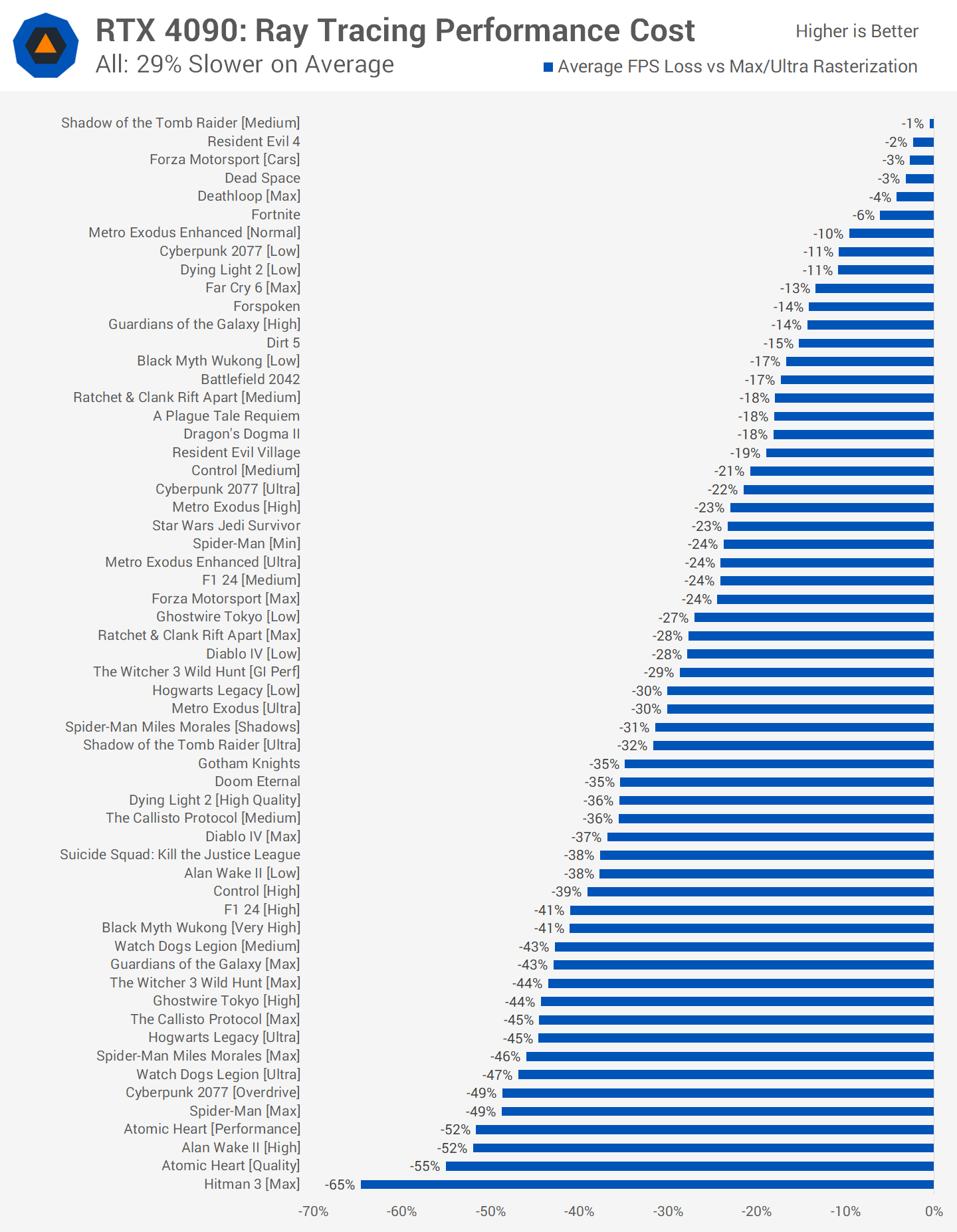
So, for a game running at 100 FPS without ray tracing, on average, enabling ray tracing will see that game run at 71 FPS. But of course, this is a simplification of all the results, as the performance impact can range anywhere from just a couple of percent, like in Resident Evil, to over a 50% performance impact, like in Atomic Heart and Hitman 3.
It’s no surprise that ray tracing is harder to run on higher settings. When we look at the lowest examined ray tracing configurations for the 36 games, the performance hit from enabling ray tracing was 22% on average. In 12 games, you could enable medium or low-type ray tracing with less than a 15% performance hit; in 15 games, the impact was between 15% and 30%, and in 9 titles, you’re facing at least a 30% hit.


When enabling maximum ray tracing in all 36 games, the average performance hit increases to 32%, and now in 21 of the 36 titles, the performance hit is over 30%, with just six games delivering less than a 15% hit.
Crucially, we can examine what the performance impact is like in games that we know have good levels of ray tracing. In our initial assessment of ray tracing visual quality, we found 24 game configurations where ray tracing was generally beneficial, so here are the results from those configurations.
On average, the RTX 4090 sees a 35% performance hit running one of these configurations, with 21 out of 24 configurations seeing at least a 20% impact. So it’s pretty safe to say that in most circumstances, with the best ray tracing GPU on the market, to get a good level of ray tracing, you’re facing at least 20% lower FPS than you were getting with ray tracing disabled.
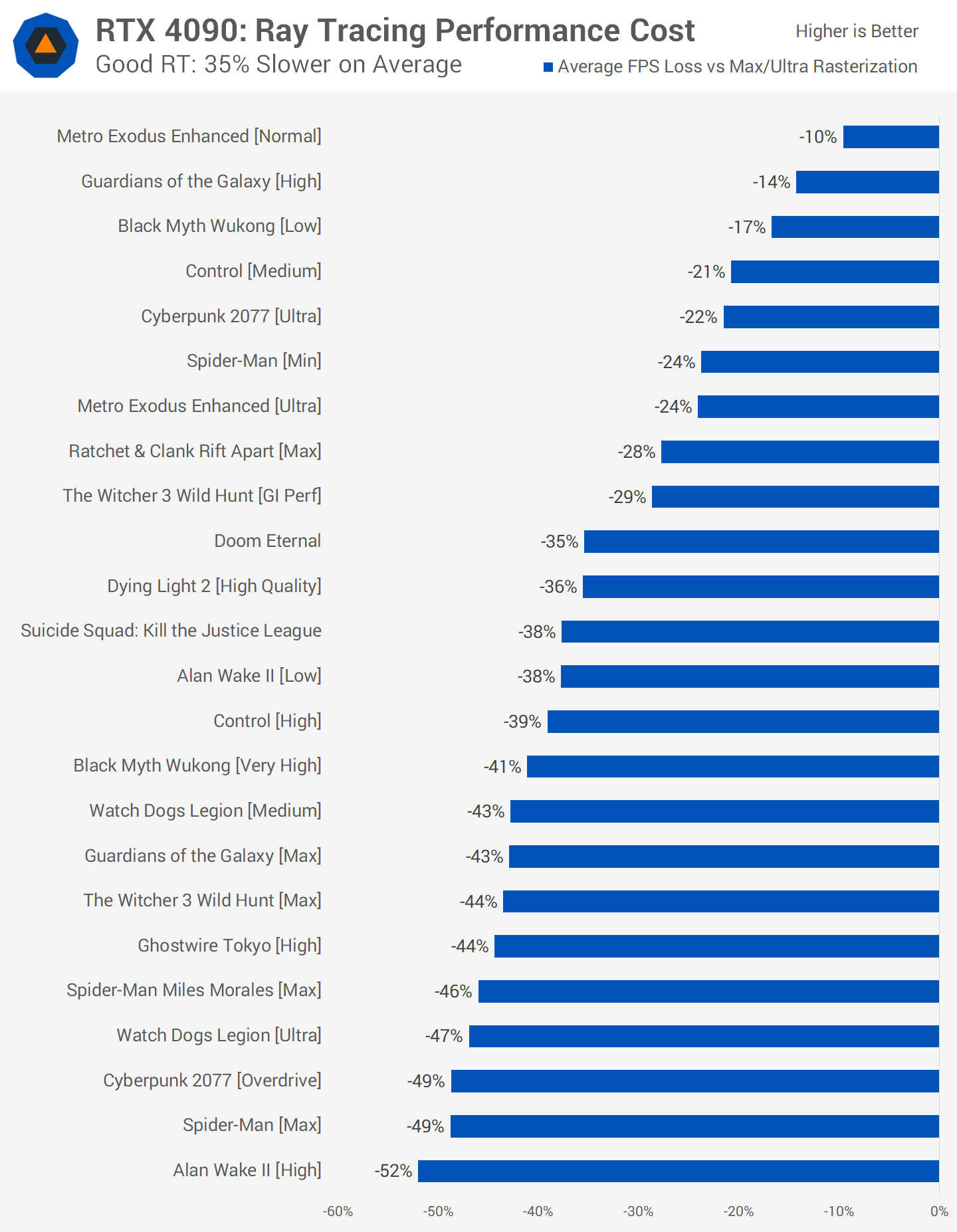

In the remaining 35 configurations we deemed generally not worth it, the average performance impact was 24%. It’s clear that the better implementations featuring more ray tracing are also more performance-taxing.
In a number of games that had visually negligible ray tracing, the performance impact was very low, such as in Dead Space, Deathloop, Resident Evil 4, and Cyberpunk 2077 on the Low preset. So, it seems those games have dialed back their ray tracing on purpose to limit the performance hit.
Ray Tracing Performance Cost on Radeon
The Radeon RX 7900 XTX is impacted to a greater degree when ray tracing is enabled. Across the 59 game configurations, the average performance impact from enabling ray tracing was 39%. This includes some enormous performance losses in path-traced configurations; without those outliers, the performance impact was more like 35% – still sizable and a larger loss than with the RTX 4090.
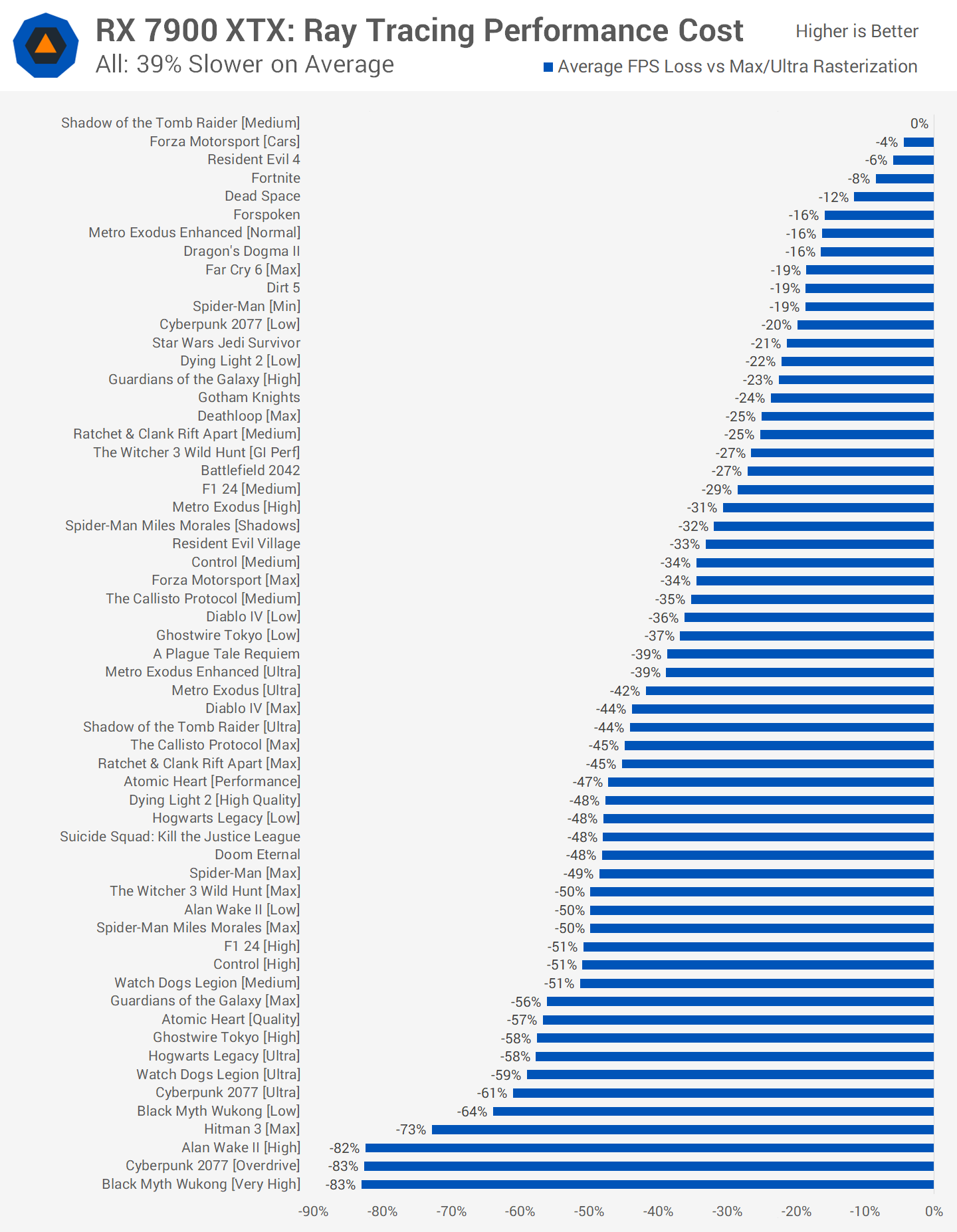
The discrepancy between low and high ray-traced configurations is also seen on the Radeon card. When the 36 games are played on a lower ray-traced setting, performance was reduced on average by 29%. But when using the highest ray-traced settings, that loss increases to 42%. That’s 10 percentage points greater than the loss suffered by the RTX 4090 in these games.
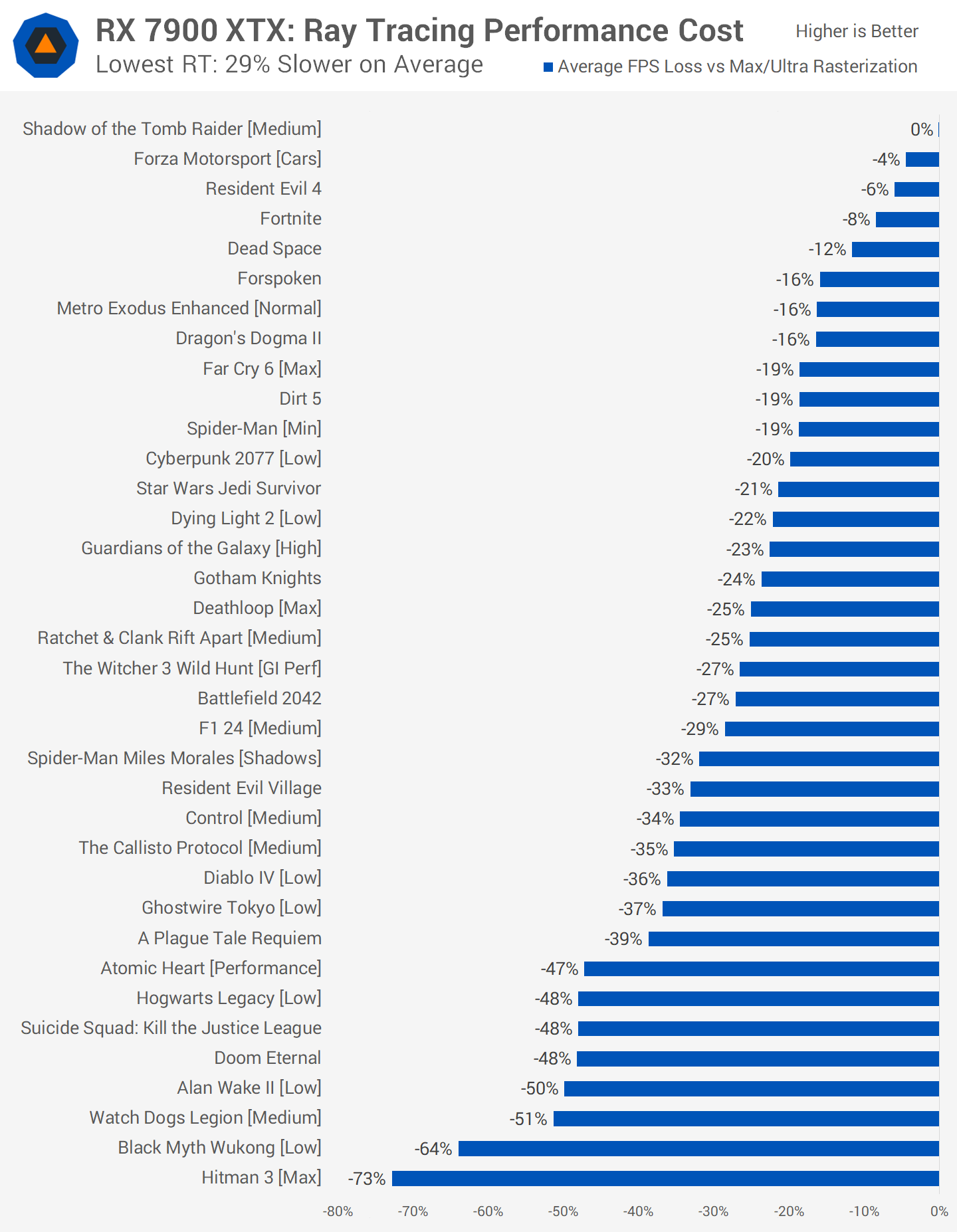
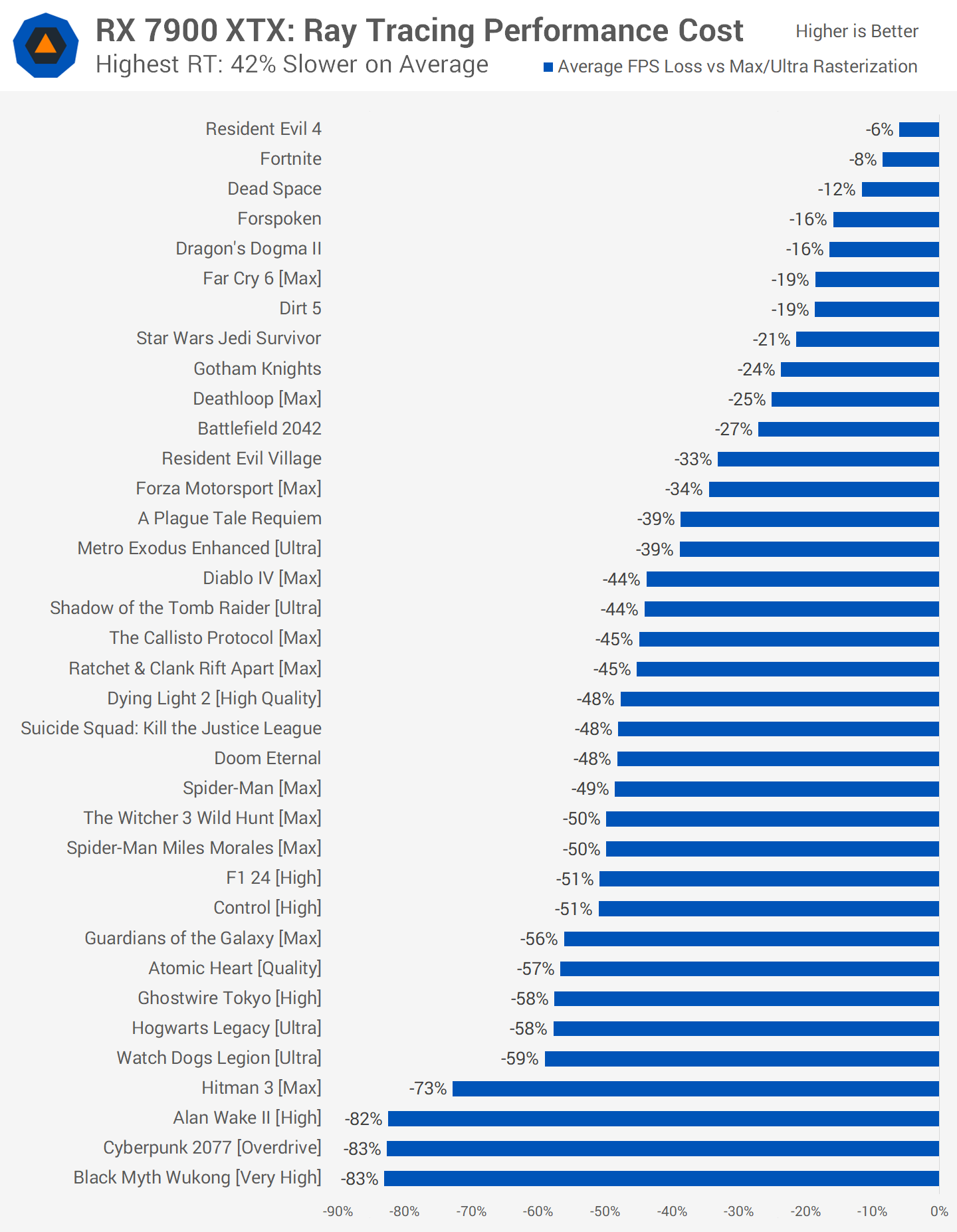
The most concerning aspect for owners of cards like the RX 7900 XTX is the discrepancy between subjectively good and bad ray tracing implementations. The average performance loss in the 24 configurations we thought were good examples of ray tracing was 50%, meaning performance halved on average when enabling ray tracing in games we think is worth using. In comparison, the hit to the RTX 4090 was only 35% on average.

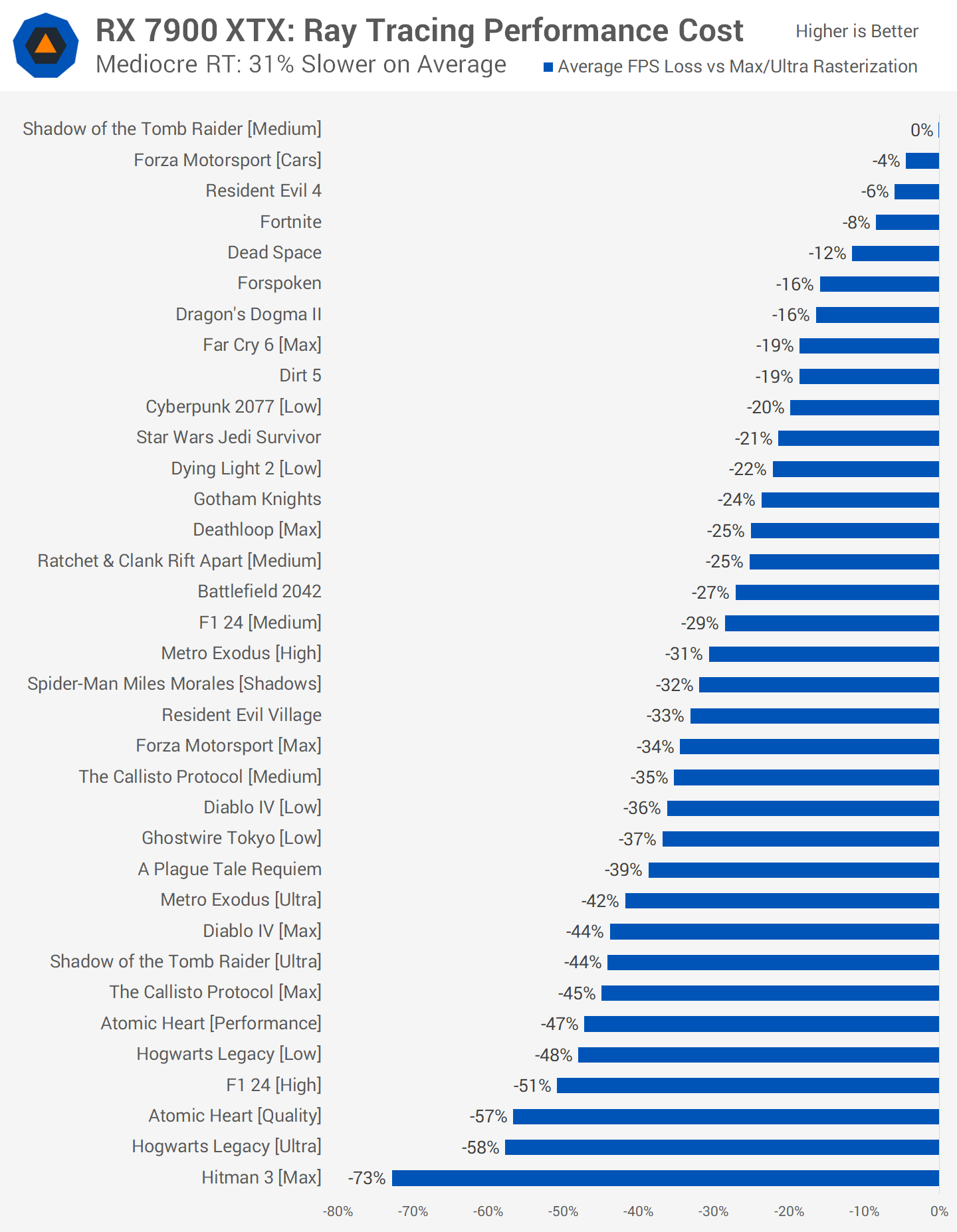
And then for the titles where ray tracing is generally not worth using, the average performance impact was 31%, compared to 24% on the RTX 4090. The gap in performance impact is much smaller when looking at these “worse” ray tracing examples, so it’s clear the 7900 XTX doesn’t struggle as much with rendering ray-traced effects when either there just aren’t many ray-traced effects enabled, or the effect quality is dialed back.
GeForce RTX 4090 vs Radeon RX 7900 XTX in Ray Tracing
This creates an interesting situation when you compare the best RTX 40 Ada Lovelace GPU to the best RX 7000 RNDA3 GPU. With ray tracing disabled, the RTX 4090 is 29% faster in our 36-game sample used for this article. That’s a pretty standard difference, very similar to what we’ve shown previously, and we know the RTX 4090 is faster overall.
Rasterization Performance (No RT)
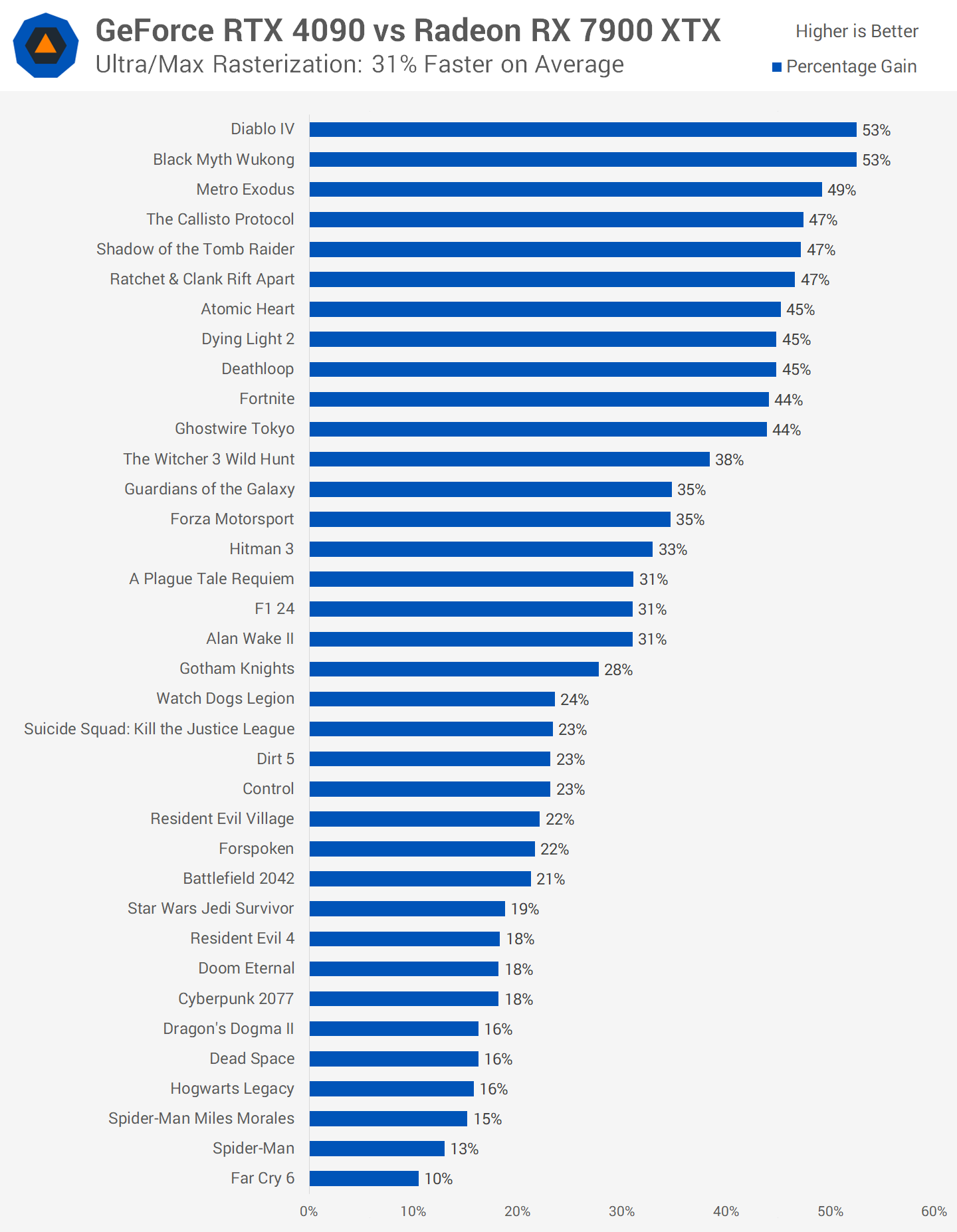
But when ray tracing is enabled, across 59 game configurations, the RTX 4090 extends its lead to end up 66% faster on average. This includes several massive outliers where path tracing is enabled; the RTX 4090 is actually capable of using those modes, whereas the 7900 XTX is not. Excluding those results and looking at normal ray-traced examples, we’re still left with a 50% performance lead for the RTX 4090.
Ray Tracing Performance

Restricting this comparison just to games where ray tracing is worth enabling, and it’s not a pretty comparison for the RX 7900 XTX. The RTX 4090 is 97% faster on average, though again this includes some huge outliers. Removing the four extreme path-traced examples, the RTX 4090 still ended up 56% faster on average, nearly double the lead it has over the 7900 XTX in ultra rasterization.
The RTX 4090 is also faster in general for the “lesser” ray-traced configurations, 45% faster on average in these examples, but it’s clear the lead extends in games where ray tracing has more visual impact. These games use more ray-traced effects, the effects are higher quality, leading to a better presentation – but it also makes the games struggle more on RDNA3.
Ray Tracing Performance (“RT Worthy” Games Only)

A lot of these examples where the RX 7900 XTX doesn’t look too bad – such as in Dragon’s Dogma II, Far Cry 6, and Resident Evil 4 – the actual amount of ray tracing used is negligible or not very impactful. Those are the games that the Radeon GPU is best at handling.
Now, the obvious talking point out of this, as we mentioned in the visual analysis, is that most of the good ray tracing examples are Nvidia-sponsored games, whereas AMD-sponsored games tend to use lower amounts of ray tracing and don’t benefit as much visually. This plays out in the performance data as well – Nvidia-sponsored ray-traced games tend to have the largest performance difference between the 4090 and 7900 XTX.
Some fanboys will immediately suggest this is because Nvidia is deliberately going overboard on ray tracing to put their cards in an especially favorable light and doing no optimization work or even sabotaging ray tracing performance on AMD cards. But we don’t think there’s evidence to say that’s the case.


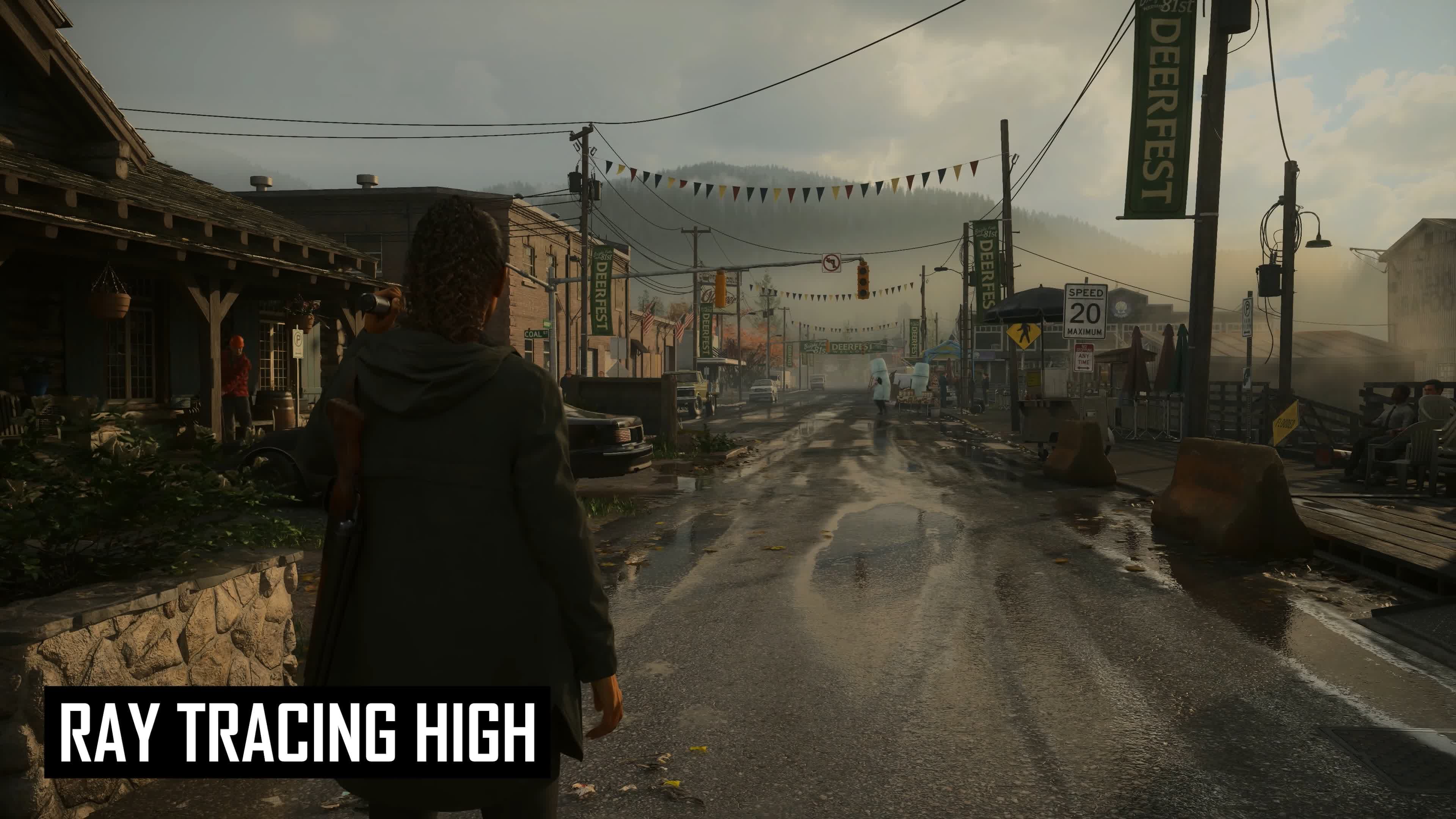
As things stand now, with the games available on the market, the conclusion we have to draw after six years is that Nvidia GPU hardware is more advanced and better for ray tracing than AMD GPUs. We haven’t seen a trend of the gap closing as newer games put in more optimization work. Many people hoped that would happen, but it really seems to be more of a hardware discrepancy than something that can be addressed in software.
Of course, this isn’t going to be news to a lot of people; we already knew GeForce cards are better at ray tracing, but now we can put some facts and figures to that discussion. The data supports that RDNA GPUs will not get better at ray tracing relative to GeForce unless the hardware itself is improved.


What we will say, though, is that games, in general, are finding ways to add more ray tracing into the mix over time without causing larger and larger performance hits relative to rasterized visuals. Part of this will be the standard of rasterized visuals also improving, so the baseline for comparison is getting better and harder to run, but at least we’re not seeing a runaway effect where the “ray tracing tax” is getting larger and harder to justify.
Is the Performance Hit Worth It?
The challenge with a lot of these games is whether the visual benefit justifies the performance cost, and we think that’s going to depend on how much value you place in visual quality.
If you’re the sort of gamer that always wants to run on ultra settings and wants the best graphics the PC platform can offer, a 30% performance hit from enabling ray tracing in some of these games is going to be acceptable. But if you’re just fine running on medium settings or if you like to optimize each setting for the best performance, a 30% performance hit from ray tracing might sound absolutely outrageous.


Whether or not ray tracing is worth enabling will also depend on how much performance headroom there is with your GPU. If a game is already running at 150 FPS without ray tracing, a 30% hit from ray tracing still means over 100 FPS on average, which, in a lot of single-player titles, is very playable and provides a great experience. But if the baseline is 60 FPS, a 30% hit drops it to a much less enjoyable 42 FPS.
There’s no doubt that ray tracing is the most performance-intensive visual setting in most games and should be enabled last. In some titles, the performance hit can be hard to justify, especially for games where the visual benefits aren’t as strong, like Hogwarts Legacy or Guardians of the Galaxy. In other titles like Cyberpunk 2077, Spider-Man, or Metro Exodus Enhanced Edition, using ray tracing outweighs the performance cost. It really depends on the game, your GPU, and where you fall on that visual-performance scale.

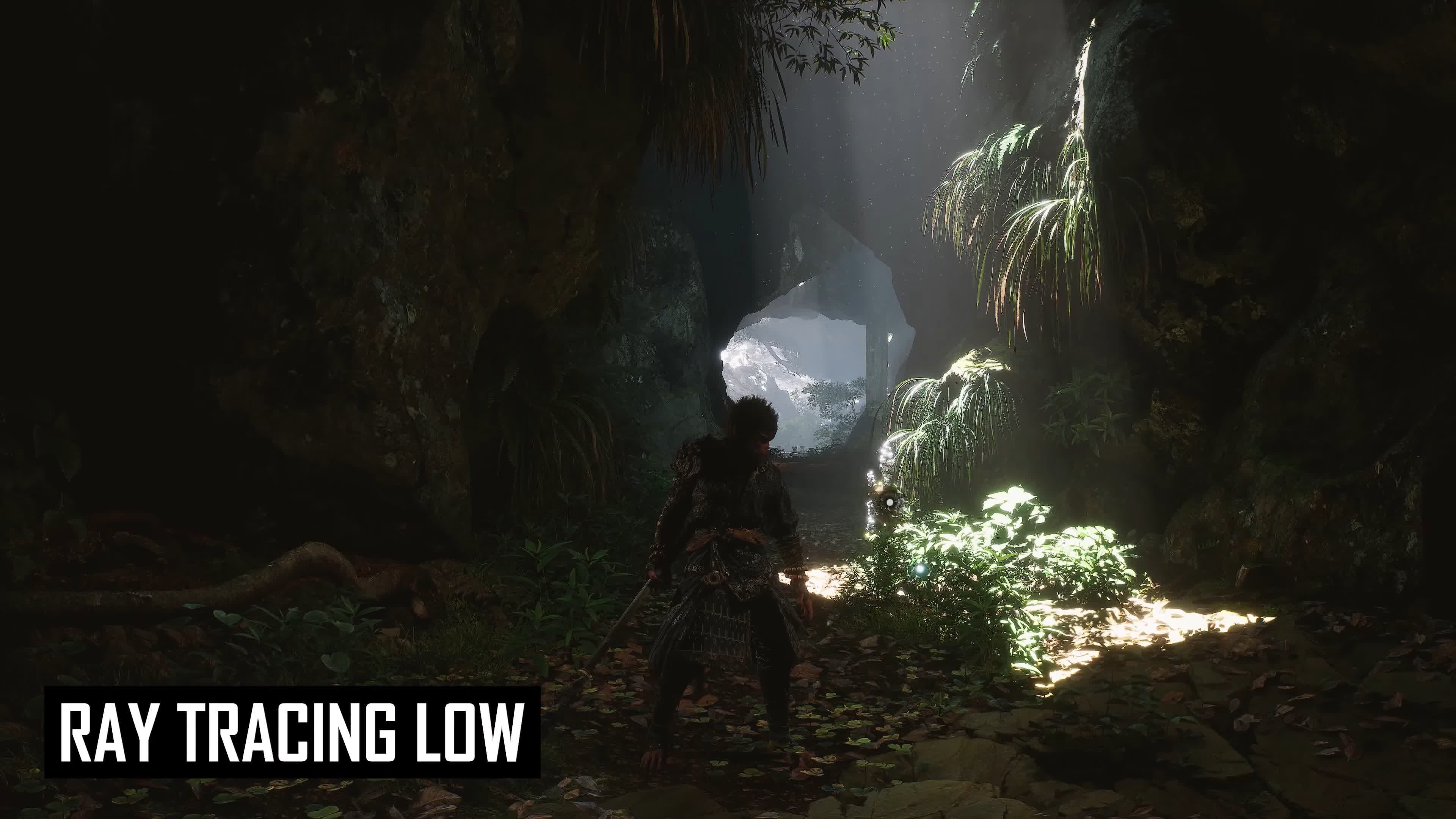
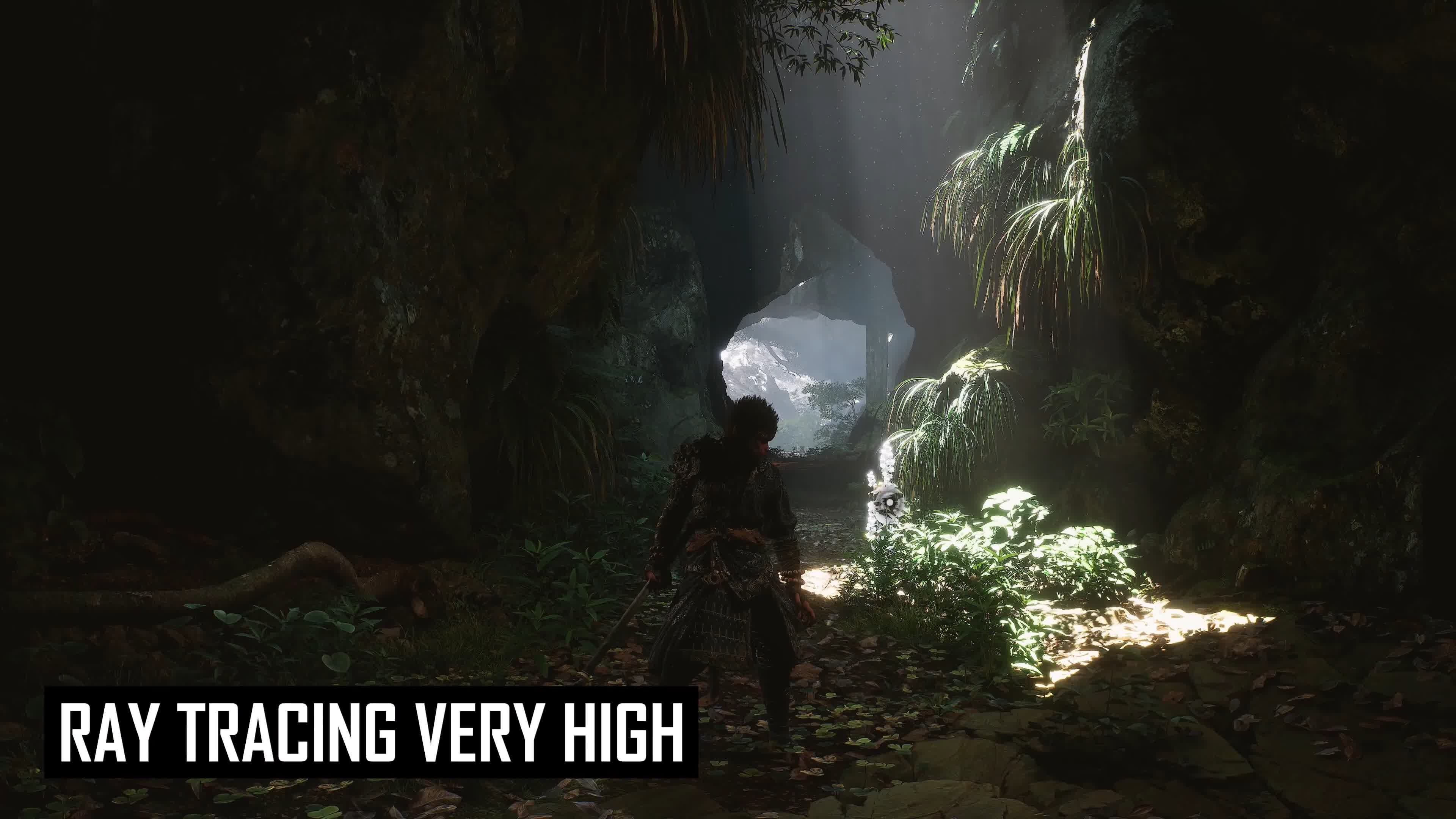
If we had to give a gut reaction to the results, based on our own biases, we’d say the ray tracing performance cost is still too large in general.
Based on visual analysis, we firmly believe path tracing is the future of high-end PC visuals because it’s the most likely to transform how a game looks and give that next-generation feel – but on an RTX 4090, all three path-traced games run at below 50 FPS at 4K using DLSS Quality upscaling. And that’s a high-end, $1,600 graphics card. GPUs need to get a lot more powerful to handle the best effects, especially in the mid-range and mainstream segments, for a ray-traced gaming future to become a reality.
Shopping Shortcuts:
- AMD Radeon RX 7900 XTX on Amazon
- Nvidia GeForce RTX 4090 on Amazon
- Nvidia GeForce RTX 4080 Super on Amazon
- AMD Radeon RX 7900 XT on Amazon
- Nvidia GeForce RTX 4070 Super on Amazon
- AMD Radeon RX 7800 XT on Amazon
- Nvidia GeForce RTX 4070 Ti Super on Amazon


